

Explore the history, culture, people and beautiful landscapes of Vietnam on the 63Stravel travel app
Download the 63stravel app

Gia Lai - a secret hidden land in the Northern Central Highlands, is not only a place of majestic natural landscapes but also a staircase of unique cuisine and colorful festivals. With its unique weather, Gia Lai transforms colors and images, creating a rich natural picture throughout the four seasons of the year. It seems that Gia Lai has hidden her beauty, causing many people to miss it with just a glance. Follow 63Stravel to explore 20+ unique tourist attractions in Gia Lai, you can't help but check-in!
Top 20+ beautiful tourist attractions in Gia Lai that cannot be missed
If you have come to the Central Highlands, you should not miss the attractive tourist attractions in Gia Lai below. This is truly the ideal place to temporarily put aside daily worries and enjoy the rustic, gentle beauty of Gia Lai.
Minh Thanh Pagoda
Minh Thanh Pagoda is located in Gia Lai, bearing the architectural features of Japanese temples in movies. With an area of 20,000 square meters, Minh Thanh Pagoda consists of many buildings designed with curved roofs, creating a unique space and attracting a large number of tourists. The pagoda is located on a hill, 2km from the city center.
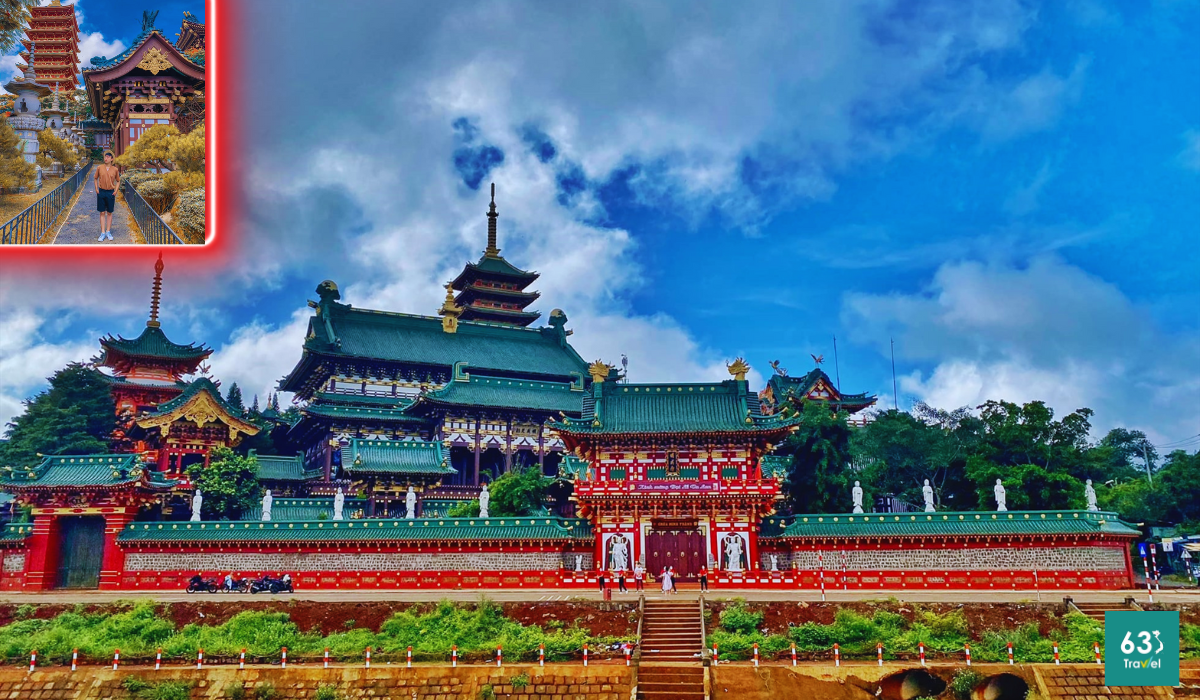
Minh Thanh Pagoda - a Japanese-inspired temple in the heart of Gia Lai mountain town
Built in 1964, Minh Thanh Pagoda has become a familiar pilgrimage and worship destination for local people. This place is considered the most beautiful temple in Pleiku, harmoniously combining Japanese architecture and a bit of Chinese architecture. From the main hall tower, willow rows and sculptures in the garden to the roof design, every detail in this building gives the feeling of entering a temple in the land of Phu Tang. The temple grounds have a quiet, ancient beauty and have many solemn Buddha statues. The back of the pagoda is also special with unique architecture and harmonious combination of colors, creating a special impression in the hearts of visitors.
Tea Lake Beach
Bien Ho Che is not only a historical tea farm, but also a cultural symbol of Gia Lai land, with traces of the French since the early years of the 20th century. Stretching on the Pleiku plateau, The vast ocean of Tea Lake is filled with the cool green color of hundreds of straight tea trees, irrigated by fresh water from T'nung Lake.
No matter what time of year you come here, the beauty of Bien Ho Che will captivate every visitor. But especially, during wildflower season (from October to November) and coffee flowering season (from February to March), this place becomes more splendid and magical than ever.
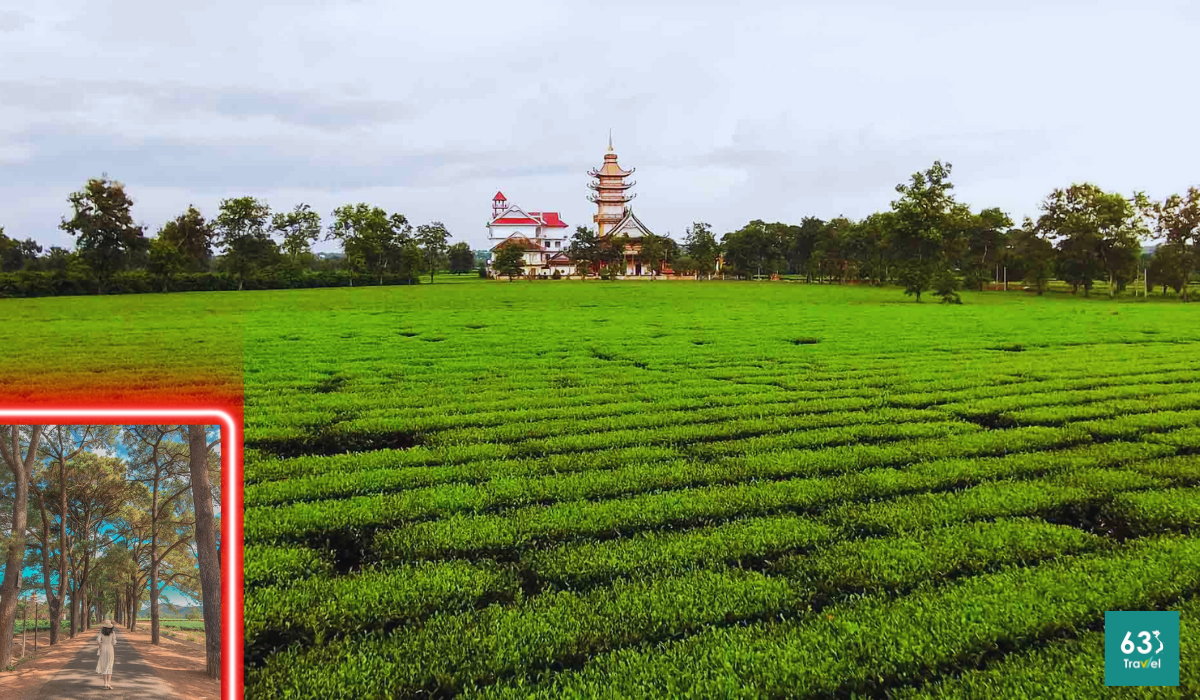
Tea Lake Beach - A cool green picture of the Central Highlands mountains and forests
Located on the plateau, the air at Bien Ho Che is always fresh and pleasant, something that visitors will never forget. In particular, the road leading here is surrounded by two rows of ancient pine trees over 100 years old, creating a poetic scene, like a vivid picture of nature.
With that unique beauty, Bien Ho Che is not only an ideal destination for those who love taking photos but also a place to experience immersion in the peaceful and relaxing space of the Pleiku plateau. Coming to Bien Ho Che, visitors will be immersed in a quiet space filled with the wild beauty of nature.
Great Solidarity Square
Dai Doan Ket Square is famous for its 12-hectare campus, featuring a 10m high statue of Uncle Ho placed on a 4.5m pedestal made from pure copper. An extremely noble and sacred symbol, bringing solemn space and solemn emotions to the Square. Behind the statue is a row of stone lotus-shaped reliefs carved with images of the life of the Central Highlands people, which is also a special highlight in this square.
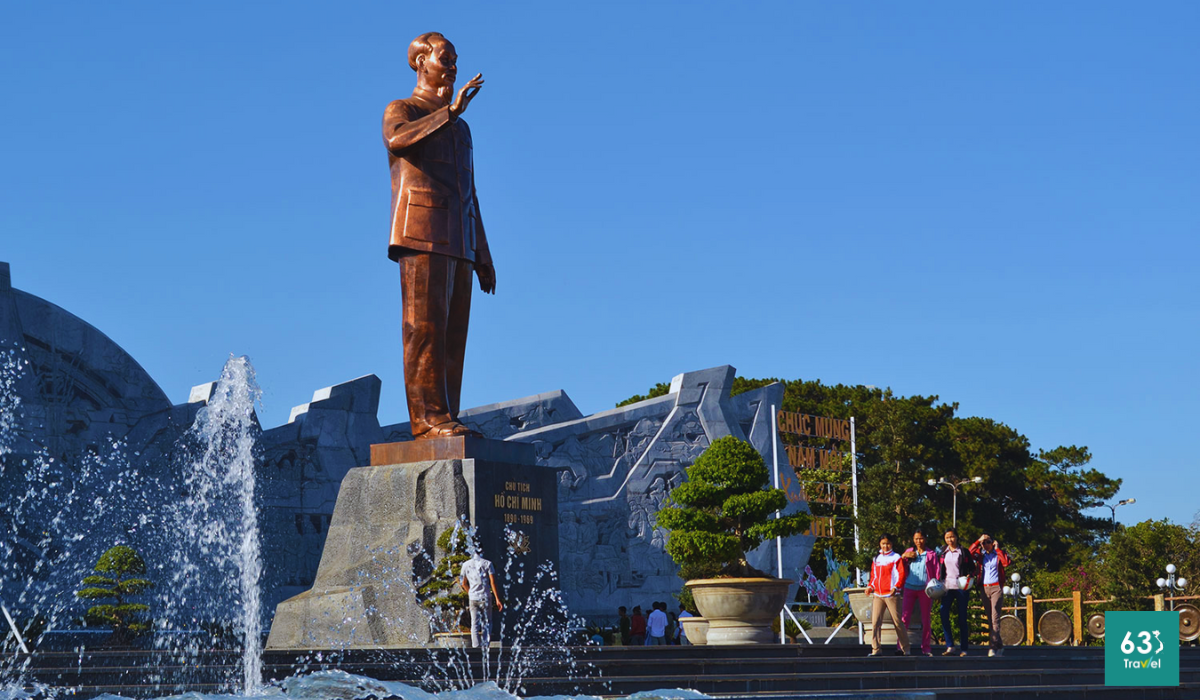
Dai Doan Ket Square - The heart of Pleiku mountain town
This is not only a square, but also the heart of the people of Pleiku, a place to express the pride and patriotism of each person here. In particular, the Square combined with the Ho Chi Minh Museum, the Museum of Antiquities and the Hero Nup Monument create a unique architectural and cultural complex, richly reflecting the cultural identity of the Central Highlands.
Located within the square grounds, there are also other monumental works such as a 3-storey cylindrical stone block symbolizing the 54 ethnic groups and a gong system - a typical symbol of the Central Highlands. Dai Doan Ket Square is a destination not to be missed when traveling to Gia Lai that you should explore.
Pleiku steep arc
Gia Lai is known as a symbol of the most romantic beauty in the Central Highlands and Pleiku road (in Ia Pech commune, Ia Grai district) is the clearest proof of this. With a delicate combination of natural scenery and human impressions, this stretch of road is not only an ideal destination for those passionate about photography but also a place to experience new and exciting moments. Great.
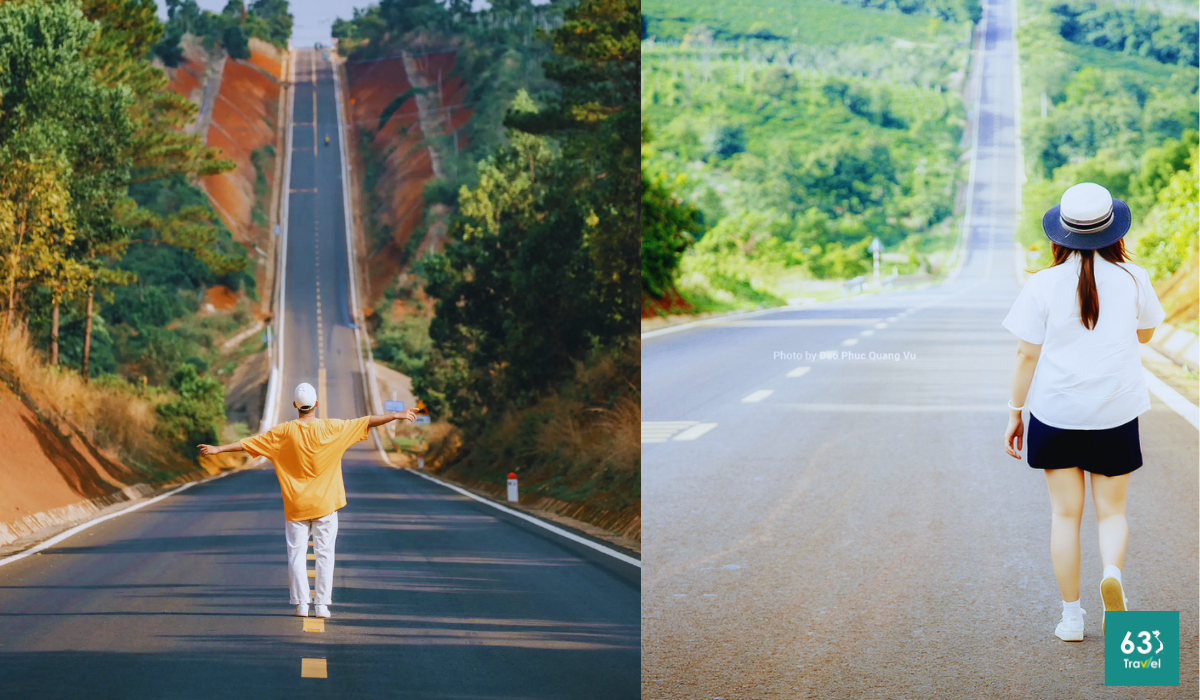
The 90-degree vertical road in the Central Highlands makes everyone's heart pound and becomes a strange check-in point
In particular, Pleiku road is not only a place to "live virtual" but also a route to avoid mountain towns with steep slopes, bringing a feeling of innocence and relaxation to each trip. With rows of green trees surrounding it, from the starting point of the road, you will not be able to see the end point, creating a mysterious and attractive feeling.
When you set foot on Pleiku road, you will be fascinated by the wild and immense beauty of nature, along with the peace and serenity that no other destination can bring. That's why Pleiku Street has become a must-see destination for those who want to find magic and sublimity in meaningful moments.
Green field
Gia Lai Green Field, as a symbol of the wild and rustic beauty of the mountainous fields, has recorded the historical journeys and meaningful stories of the people here. With the beauty of the lush green vegetation, the green fields are not only a destination but also a symbol of the traditional culture and simplicity of the Gia Lai people.
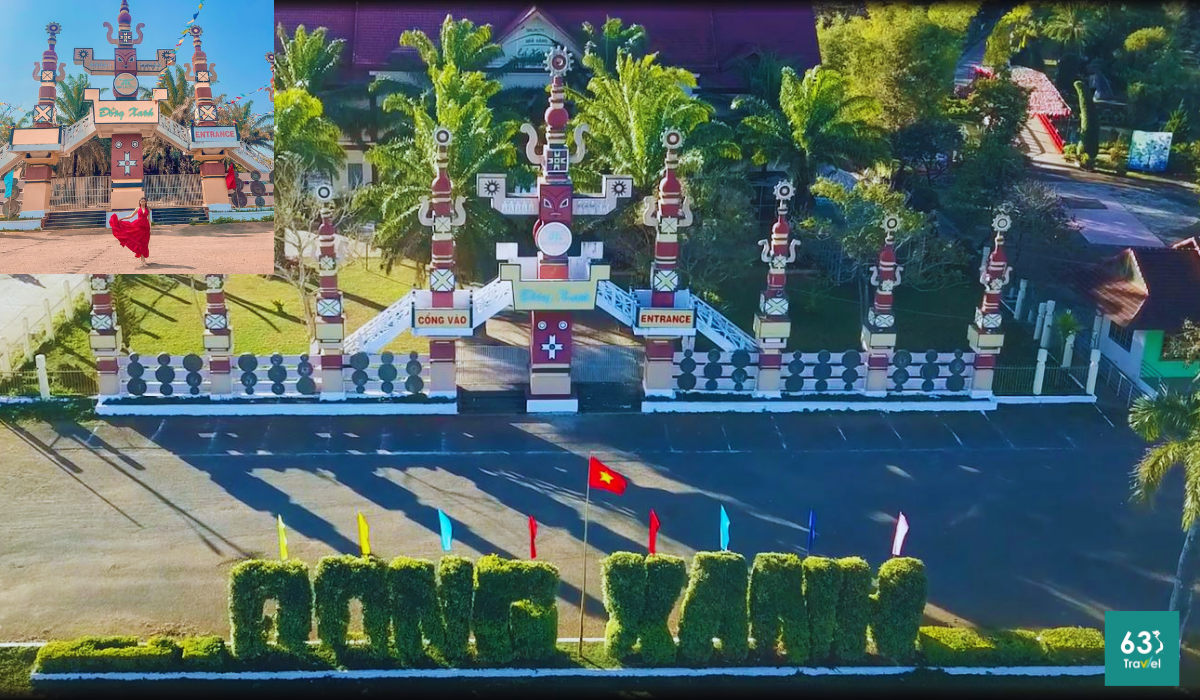
Visit Pleiku Green Field - a poetically beautiful miniature Central Highlands
Stepping into Dong Xanh Gia Lai, you will be immersed in the vast and cool space of the field, feeling the peace and relaxation that nothing can compare to. From the rustic countryside, the image of green fields has become an indispensable part of the lives of the people here, creating a unique and rustic cultural beauty.
Ba Chu Pah Waterfall Lake
Thac Ba Lake, a large lake located in Gia Lai province, is not only the destination of a hydroelectric dam named Thac Ba, but also a symbol of close and friendly beauty. With its vast and attractive scenery, Thac Ba Lake always attracts the love and desire to explore from many people.
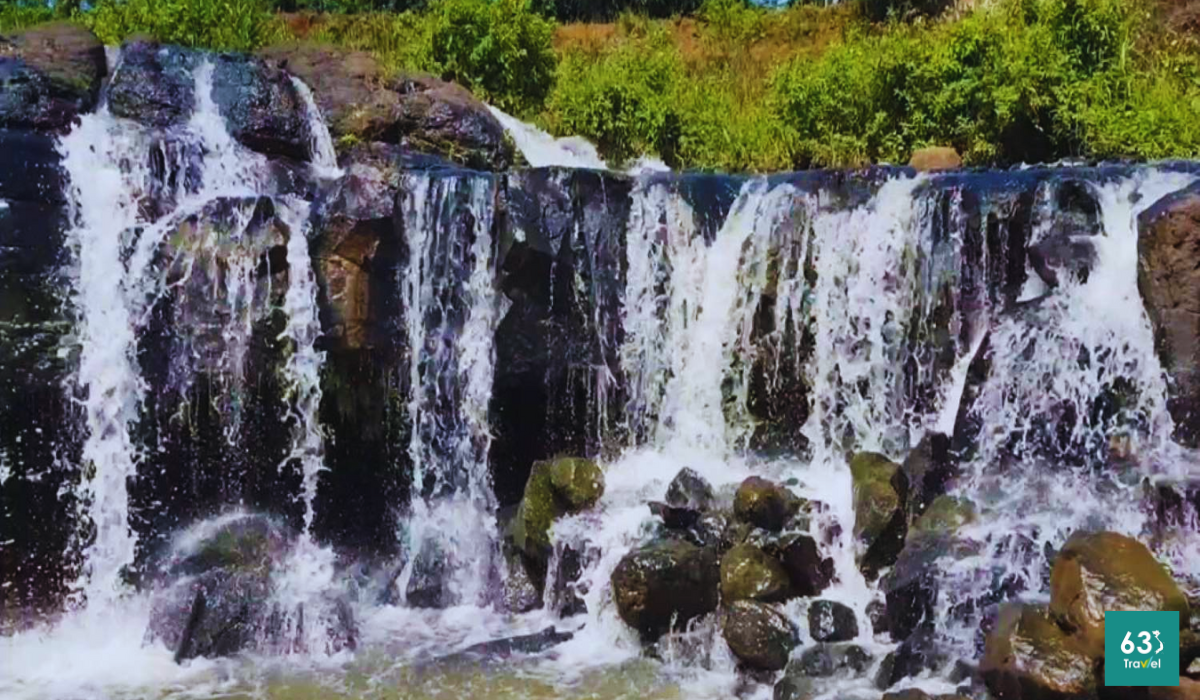
Gia Lai Thac Ba Lake - a famous place with its majestic beauty
The beauty of Thac Ba Lake really goes beyond what people expect. That's what makes everyone who comes here feel surprised and amazed by the wonderful natural beauty that this place has to offer. Every scene, every perspective makes the travel journey more interesting and memorable than ever.
Chu Dang Ya volcano
Located more than 20km from the city center, Chu Dang Ya volcano has become a favorite destination for nature exploration enthusiasts. The phrase "Chu Dang Ya" in the J'rai ethnic language means "wild ginger", and is related to an ancient story.
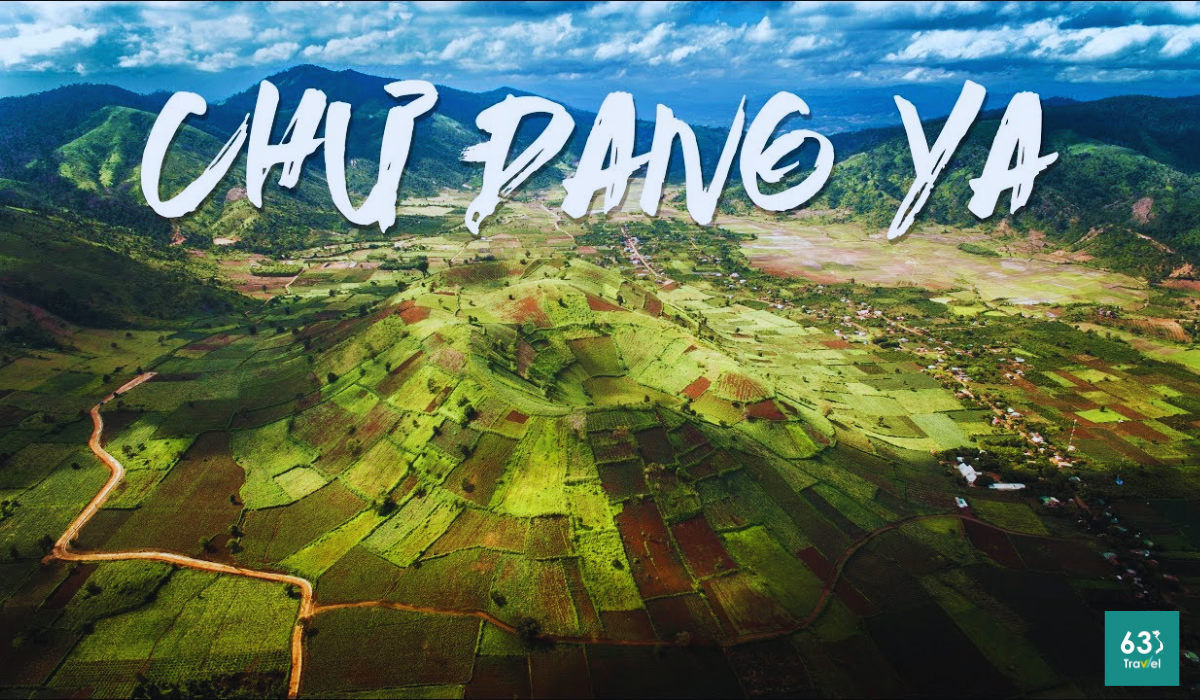
The beautiful beauty of wild sunflowers on the top of Chu Dang Ya volcano
Located among the rectangular fields of Plei Lagri village, Chu Dang Ya volcano has been inactive for millions of years. Its poetic and peaceful beauty still captivates the hearts of tourists when visiting. From rows of ancient trees to vast fields, this volcano is like a wonderful natural picture.
Traces of volcanic lava create a fertile red basalt soil, making the surrounding green and lush. October - November is the best time to visit, when this place is immersed in wildflower season. The virtual golden color of wild sunflowers and the wild sunflower festival bring a bustling and exciting space to visitors.
Phu Cuong Waterfall
Phu Cuong Waterfall, one of the most beautiful waterfalls in Gia Lai, offers visitors a peaceful and quiet space in the heart of pristine nature. Only about 3km from Chu Se town, visiting and exploring the waterfall becomes easy and convenient.
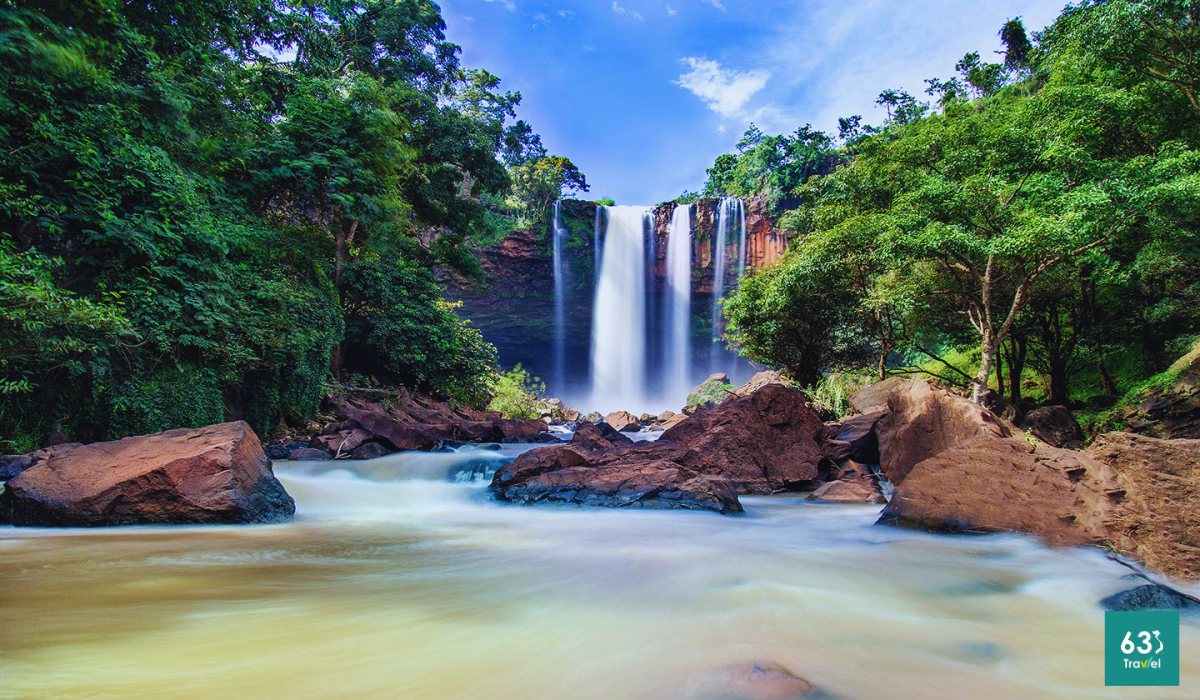
Phu Cuong Waterfall - "White silk strip" between heaven and earth in Gia Lai
With poetic beauty and clear blue water, Phu Cuong Waterfall gives visitors a feeling of relaxation and gentleness. The vibrant water falls from above like a strip of white silk, creating a wonderful scene, making every trip here an exciting and memorable experience.
Tan Son Dam
Located close to the road leading to Chu Dang Ya mountain, Tan Son dam is a new check-in point, just over 25km from the city center. This area belongs to the basin of Tonle Sap, including dams, canals and reservoirs, floating among vast forests and mountains.
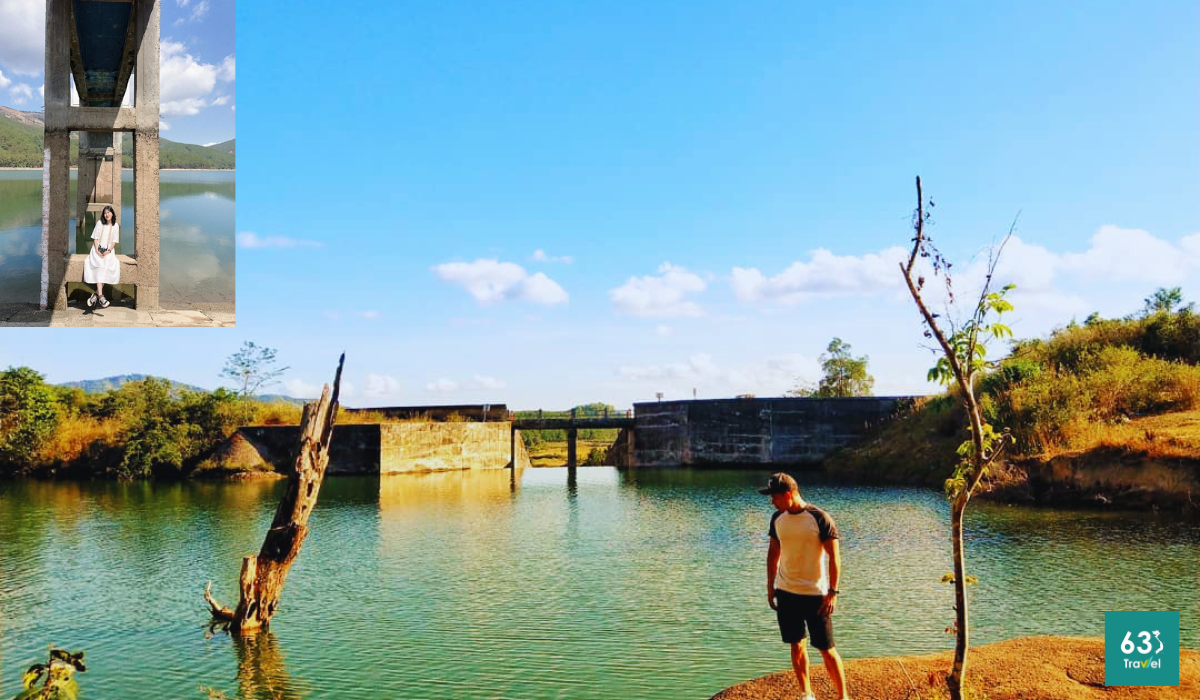
Tan Son Dam - a peaceful and clear place located next to bustling Pleiku
The beauty of Tan Son Dam is like a pristine natural painting, from the gentle blue water to the cool forest trees and wildflowers on the banks. Each season brings its own beauty, but especially in the dry months, when the valley on the banks is resplendent with torus flowers, reeds and iridescent flowers.
Tan Son Dam is described as a romantic and gentle muse of Pleiku, with a landscape of winding mountains and forests and a calm, peaceful lake. This is the place to enjoy the most peaceful and gentle feeling. And with its close proximity to Pleiku city center, you can visit Tan Son dam for a full day of picnicking.
Chu Se pink grass hill
Chu Se pink grass hill is an enchanting destination for those who love backpacking and exploration. The special color of pink grass creates a unique and attractive landscape picture, making it an ideal choice for taking check-in photos and enjoying the scenery.
If you have ever been fascinated with the pink grass hill in Da Lat, the Dak Doa pink grass hill in Gia Lai is no less impressive. This is the hottest destination in November, when pink grass blooms in the middle of the pine forest, creating a dreamy, romantic scene.
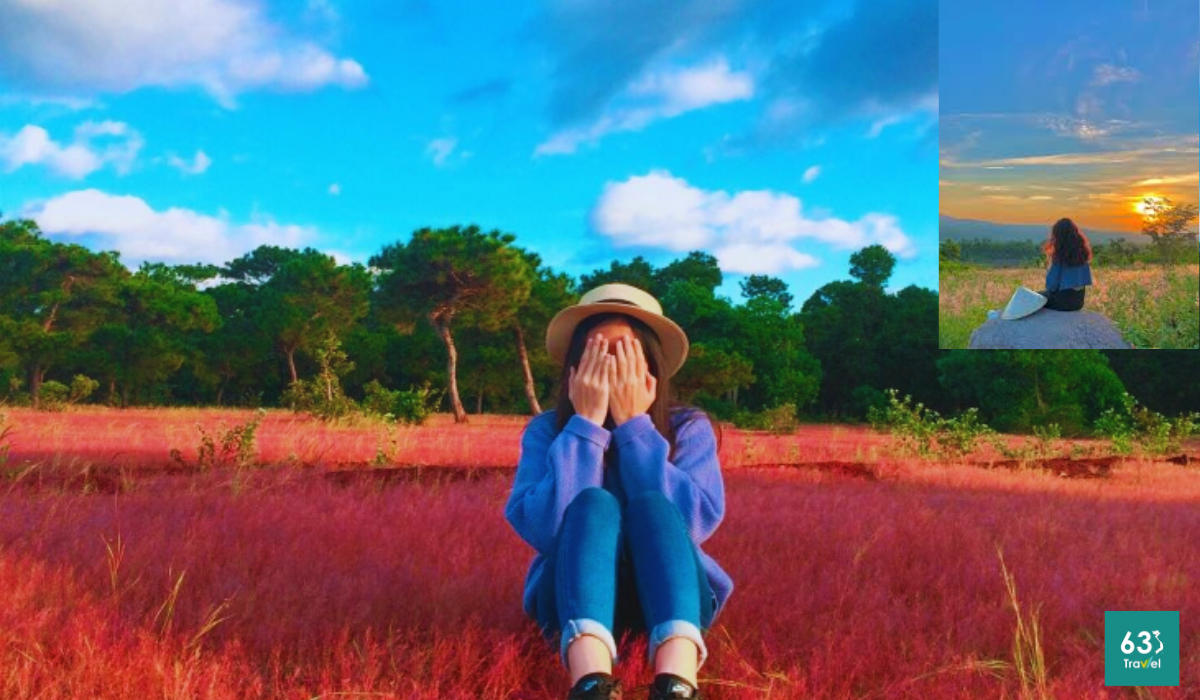
Chu Se pink grass hill - Gia Lai is dreamily beautiful in the middle of the mountains and forests, attracting tourists
Dak Doa Pink Grass Hill is about 20km from the center of Pleiku, you can easily get here by Highway 19, turn right at the roundabout in the center of Dak Doa town, then turn into Glar commune and go another 500m to get there. This is also known as the "Glar pink grass valley".
During the pink grass season, this is a destination that attracts a large number of tourists, from photography enthusiasts to families camping. In addition, there is another pink grass hill in Chu Se district, where you can explore in the early morning or sunset to enjoy the exquisite beauty of nature.
Pleiku Stone Mountain
A famous new tourist destination in Gia Lai recently is Pleiku Stone Mountain. Located on the outskirts of the city, this mountain was originally just an old stone mine, which was later converted into a cattle grazing area. However, the rustic beauty of Pleiku Stone Mountain has attracted a large number of tourists.
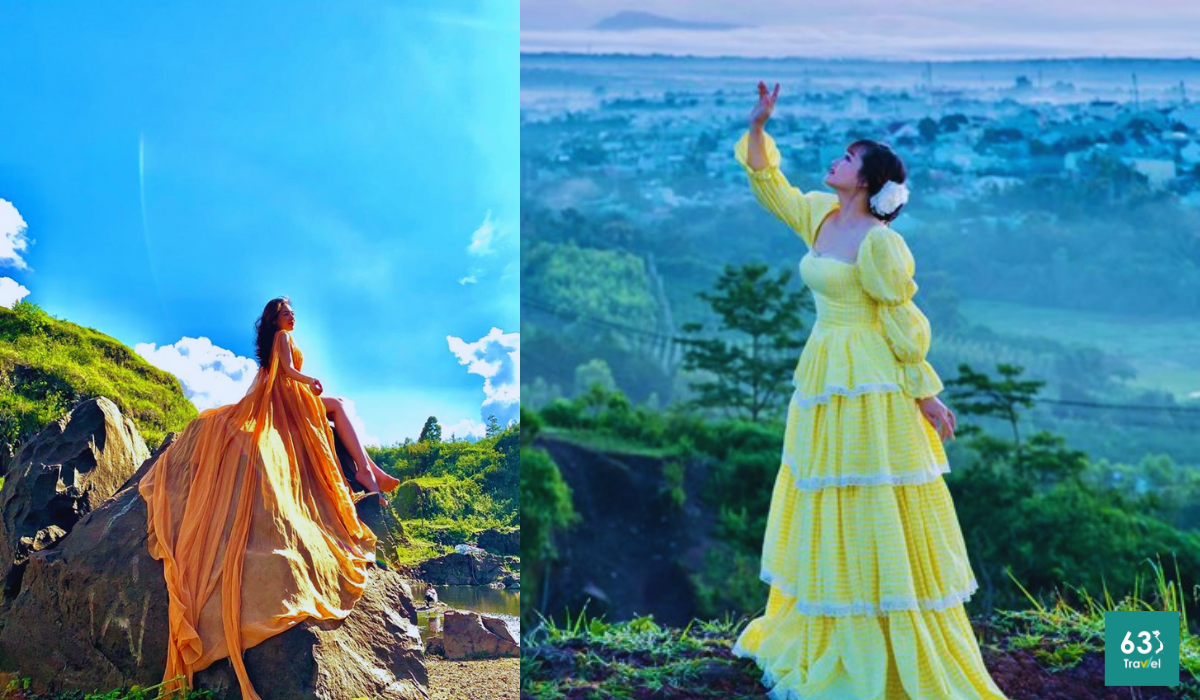
Check-in to Pleiku rocky mountain - the beautiful 'view hill' embracing the entire highland mountain town
From the top of Da Mountain, you can see the entire beautiful scenery of Pleiku below, from the vast forests, clear blue lakes to the rows of townhouses in the distance. Everything seems to shrink from the perspective of the mountain top. Because Da Mountain still retains its wild look, you can stop camping overnight and do self-cooking activities after trekking here.
Dak Doa wind power field
The majesty and immensity of Dak Doa wind power field will make you admire. This is an extremely hot check-in point for young people, with modern and sophisticated beauty. A poetic scene, especially impressive when viewed at dawn or dusk.
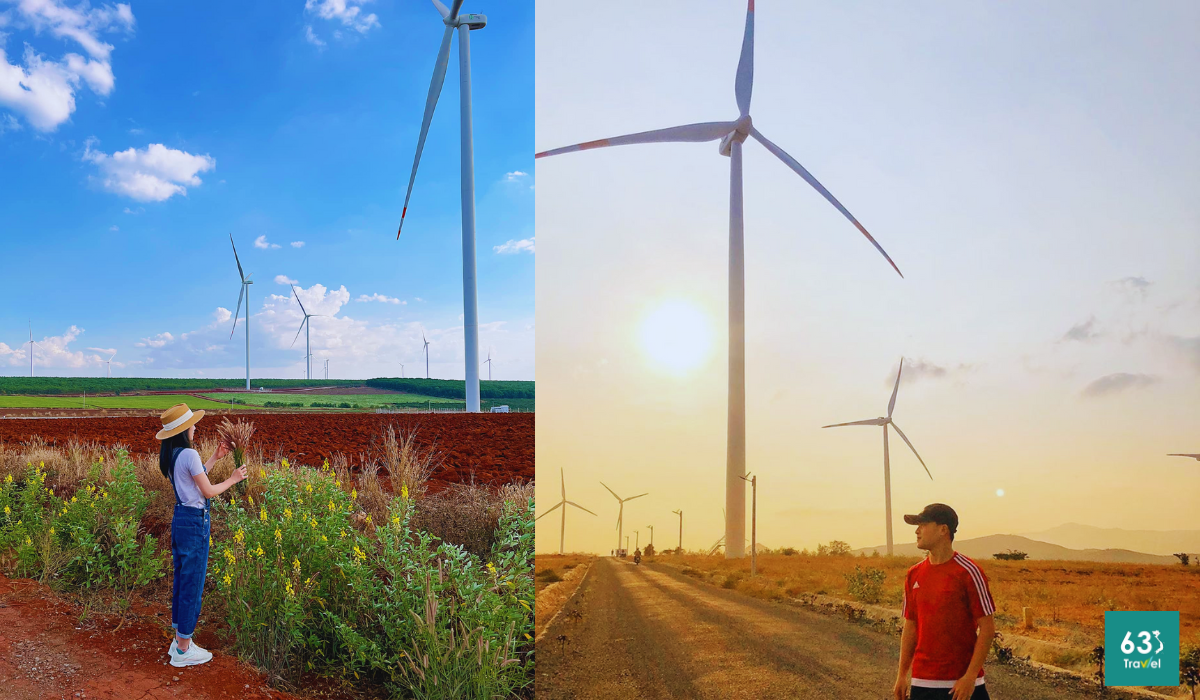
Extremely leisurely check-in with Dak Doa Fan Field (Gia Lai)
Hundred-year-old pine trees
Hundred-year-old pine trees are an impressive tourist destination in Gia Lai that you cannot miss. The age of these pine trees cannot be known exactly, we only know that they began to appear when the French arrived and established the Tea Department. This is also the first tea plantation on Pleiku, built in the early 20th century.
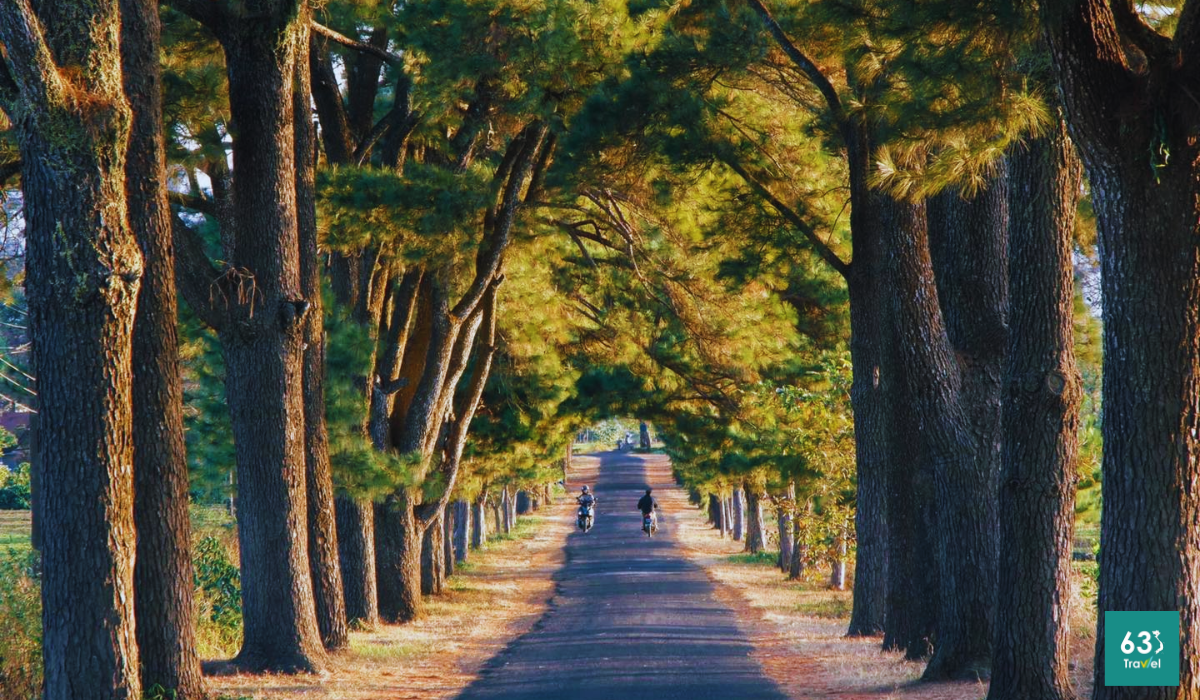
Admire the hundred-year-old pine trees in the vast land of Gia Lai
These rows of pine trees were planted and cared for by the workers of the Tea Department and over time, they developed into a green road, connecting the villages together. Located about 15 km from the city center, this is also close to many other tourist attractions such as Chu Dang Ya volcano and Buu Minh pagoda.
Ancient pine trees grow on both sides of the road, creating a cool and peaceful space. You can take impressive check-in photos here. The straight rows of pine trees combined with the surrounding peaceful scenery will help you create beautiful and attractive photos. The road with hundred-year-old pine trees on both sides is also called "Korean road" by tourists.
Ham Rong mountain
Adding a new destination to the list of tourist destinations in Gia Lai worth checking in is Ham Rong Mountain. Located in Pleiku city, this mountain is 1028m high and is considered the "roof" of this mountain town. Just follow Highway 14 from the inner city and you will reach this place.
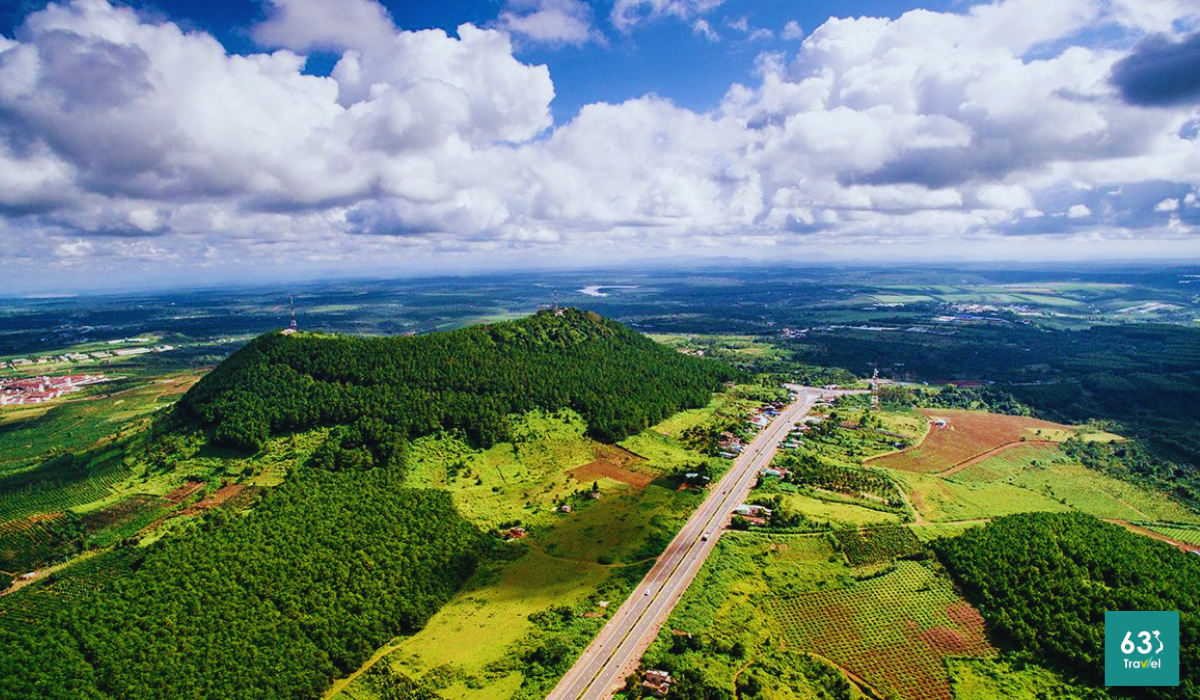
Ham Rong Mountain with beautiful majestic landscape in Gia Lai
The most interesting thing about this mountain is its unique shape like no other. From above, Ham Rong Mountain looks like a "giant" upside-down funnel with long grooves from the mouth to the mountainside. Although there are no rivers or lakes surrounding it, the primeval forests in the mountains are still very green.
Similar to Chu Dang Ya mountain, the paths at the foot of Ham Rong mountain are filled with wild sunflowers. Coming in October - November, you will see the brilliant yellow "covering" everywhere. Come early in the morning to enjoy the mist covering the entire mountain, creating a poetic and romantic space.
T'Nung Lake
T'Nung Lake, also known as Bien Ho, is a tourist destination not to be missed when coming to Gia Lai. Located in the middle of the plateau, this lake includes two natural lakes, surrounded by green pine forests and rolling mountains. With its magical beauty and clear water like a mirror, this lake is truly an ideal place for tourists who want to enjoy a peaceful space and create unique check-in photos.
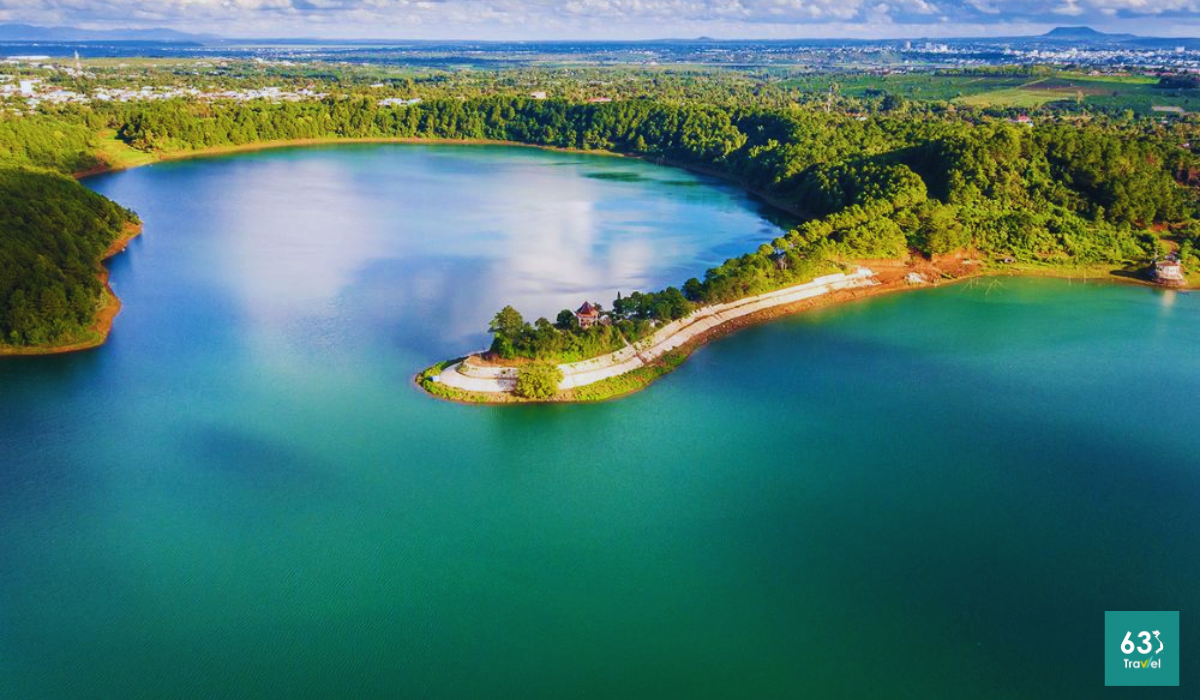
To Nung Lake - Stunned by the beauty of the lake and the mountains in the Central Highlands
The water surface area of Tonle Sap Lake is up to 230 hectares, bringing a cool and pleasant feeling in the hot weather of Gia Lai. Also known as "green lungs" or "Pleiku eyes", this lake attracts tourists with its wild and attractive natural beauty.
Kon Ka Kinh National Park
Kon Ka Kinh National Park is an ideal destination for those who love to explore the flora and fauna ecosystem in Gia Lai. Exploring this national park not only brings the opportunity to admire rare animals but also brings a wonderful experience in a cool green natural space.
The journey to conquer Kon Ka Kinh National Park will take you on a "hunt" for rare animals. At the same time enjoy the fresh and cool atmosphere. This is truly a destination not to be missed when you plan a trip to explore Gia Lai.
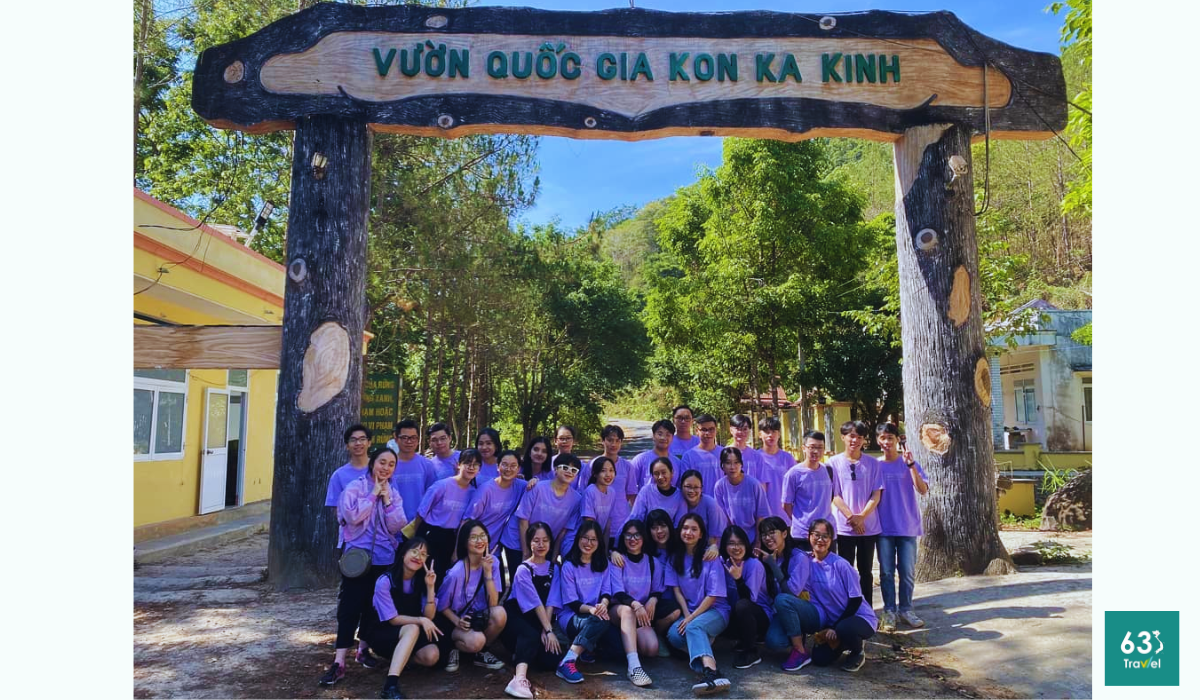
Travel to Kon Ka Kinh National Park "the roof of Gia Lai"
Kon Ka Kinh National Park has been honored as one of the ASEAN heritage parks since 2003. During the trekking journey, you will enjoy the diverse flora and fauna, and at the same time admire the majestic scenery of the mountain range. Truong Son when reaching the top of the mountain.
With a total area of up to 42,000 hectares and presence in 5 communes, Kon Ka Kinh is a vast and wild land. This place is famous for its system of rivers, waterfalls, and streams, and provides an authentic trekking experience amid the wild and majestic nature of Vietnam's special-use forests.
Ialy Hydroelectric Power Plant
Ialy Hydroelectric Plant is not only an important technical project on the Sesan River, but also a destination that attracts tourists to explore the wild beauty of Gia Lai land. With a capacity of 720 MW, this is one of the largest hydroelectric plants in Vietnam, contributing to providing electricity to the entire Central Highlands region.
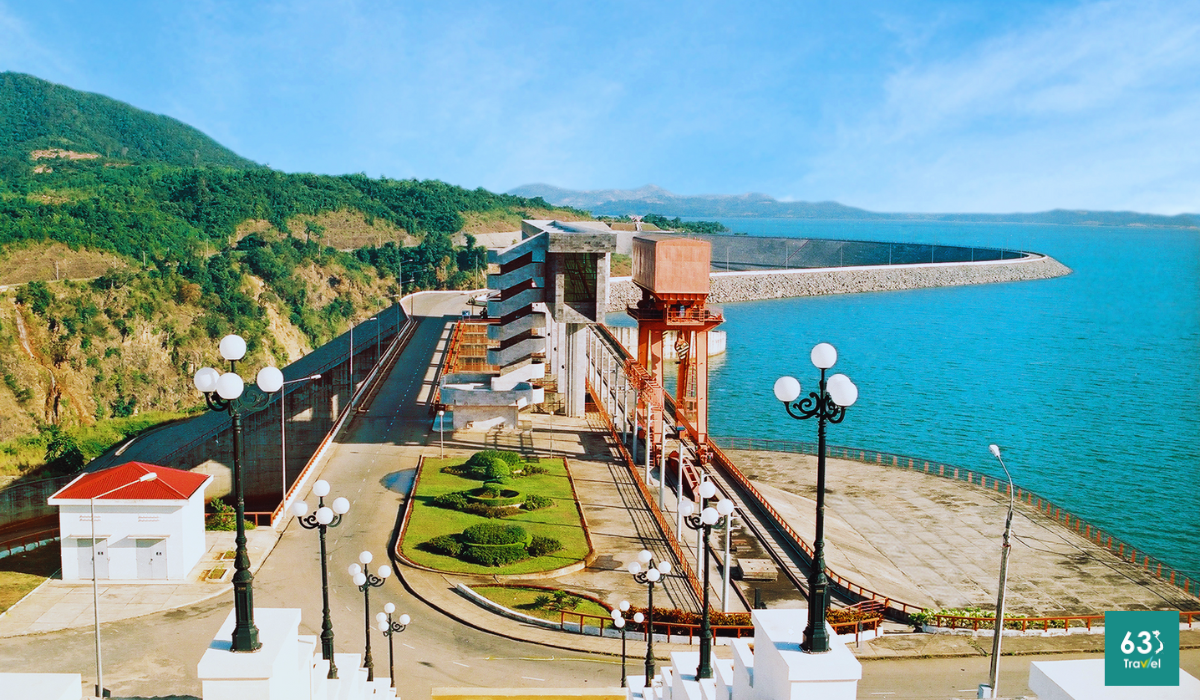
Yaly Hydroelectric Power Plant - The largest light source in the Central Highlands
When arriving at the Ialy hydropower plant, visitors will be fascinated by the wild and majestic beauty of the cascading waterfall. In particular, the adventurous experience on a suspension bridge made from ropes will make them feel excited and nervous, but at the same time surrounded by a feeling of safety and certainty. This is truly an unforgettable experience when coming to Gia Lai.
Buu Minh Pagoda
Buu Minh Pagoda, a stellar pearl in the mysterious land of the Central Highlands, brings visitors into a world of purity and peace. Located deep in Nghia Hung village, Chu Pah district, Gia Lai province, Buu Minh pagoda is famous for its unique solemnity and tranquility.
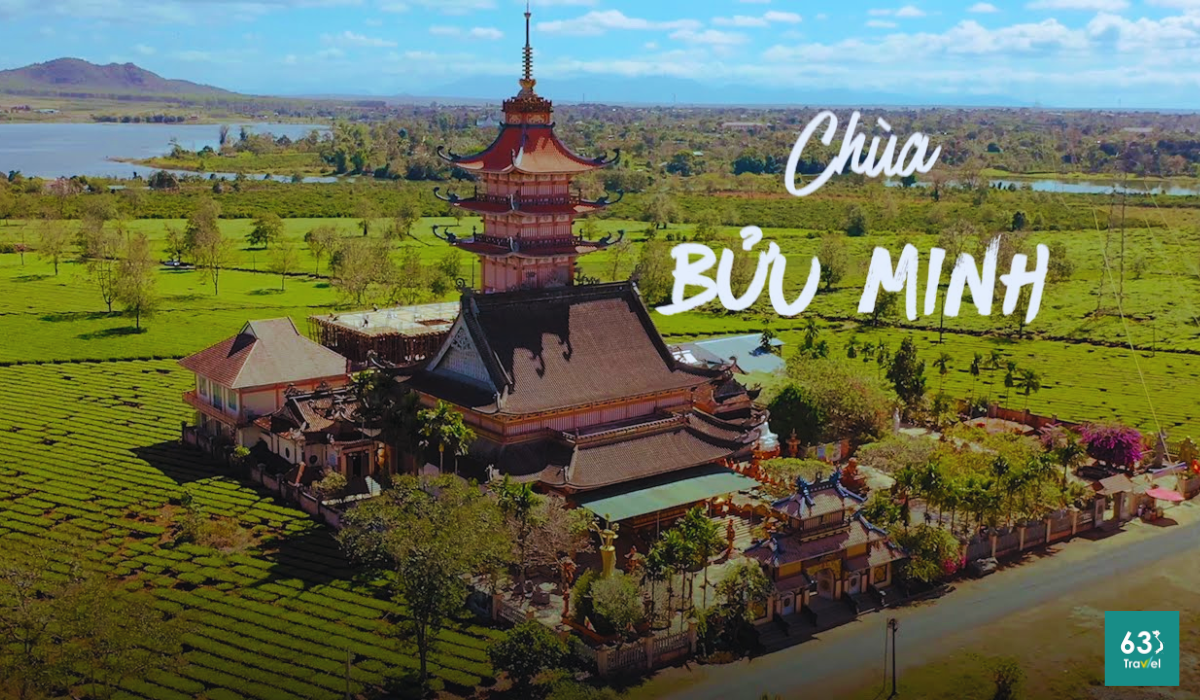
Buu Minh Pagoda - Ancient pagoda in the middle of vast green tea hills
From afar, tourists will be attracted by the beautiful natural scenery, with cool green tea hills surrounding the pagoda. The special feature of Buu Minh is not only its external beauty but also the profound historical story about its formation and development.
Buu Minh Pagoda is not simply a spiritual building but also a symbol of the cultural and historical connection between humans and nature. From the old "Rattan Grass Hamlet", where residents from the coastal plains came to mark the beginning of a new life, Buu Minh Pagoda has entered the hearts of the people and become a an indispensable part of spiritual life in this land.
Pleichuet Church
Pleichuet Church is one of the unique cultural and religious symbols in the center of Pleiku city, Gia Lai. With its architectural style resembling the communal house of the Central Highlands people, this church is not only a place of worship for local people but also a destination that attracts the attention of tourists.
Located on Truong Dinh Street, Pleichuet Church makes a strong impression with its beauty and solemnity. With an area 5 times larger than normal communal houses, this place is not only a living place for more than 1,400 parishioners but also an interesting tourist attraction for tourists.
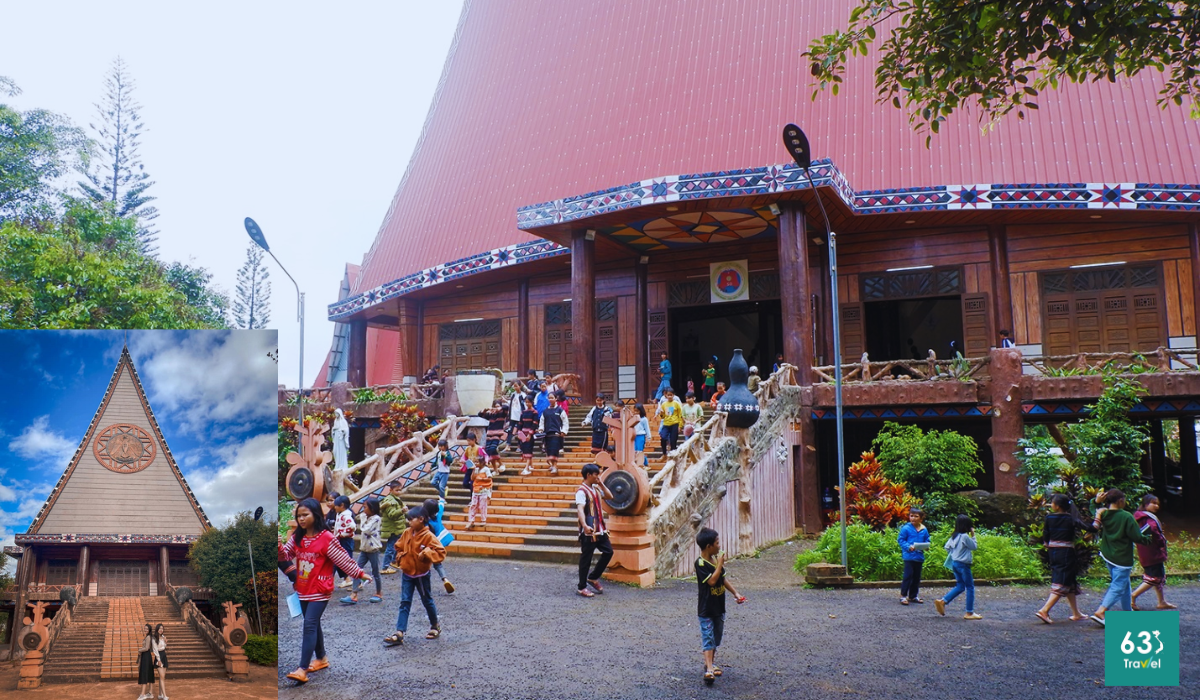
The church has a unique communal house architecture in Pleiku
Although it is a religious site, Pleichuet church is also open to visitors who want to explore and learn about the culture and spiritual life of the local people. Especially on holidays, the atmosphere here becomes vibrant and filled with cultural colors.
When visiting Pleichuet Church, visitors need to comply with a number of regulations such as wearing discreet and polite clothing, as well as paying attention to the ceremony time frame to avoid causing inconvenience to ongoing religious ceremonies. Learning and respecting these regulations will help visitors have a more enjoyable and meaningful experience when visiting Pleichuet church.
Nine-Layer Waterfall
Nine Floor Waterfall is one of the famous tourist destinations in Gia Lai, where the meandering water flow and huge cliffs blend together. Combined with the lush primeval forest, it creates a wonderful wild picture.
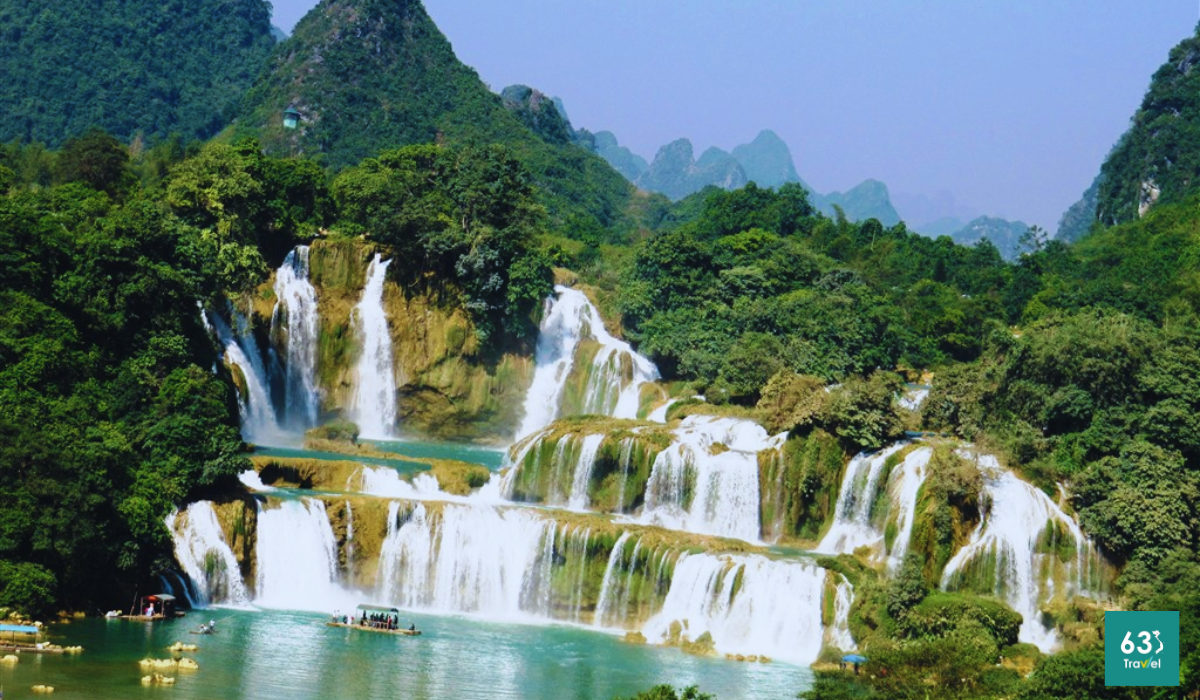
Overwhelmed by the magnificence of the 9-tier waterfall
When standing at the top of the waterfall, the sound of water pouring from above echoes continuously, bringing a feeling of peace and freshness, helping us forget all the troubles in daily life. Nine-Storey Waterfall is not only an ideal stop but also a place to enjoy serenity and immerse yourself in the wild beauty of nature.
Dien Hong Park
Dien Hong Park is one of the popular entertainment spots in Pleiku City. Known for two large freshwater lakes, playing an important role in regulating and storing water for Pleiku city center.
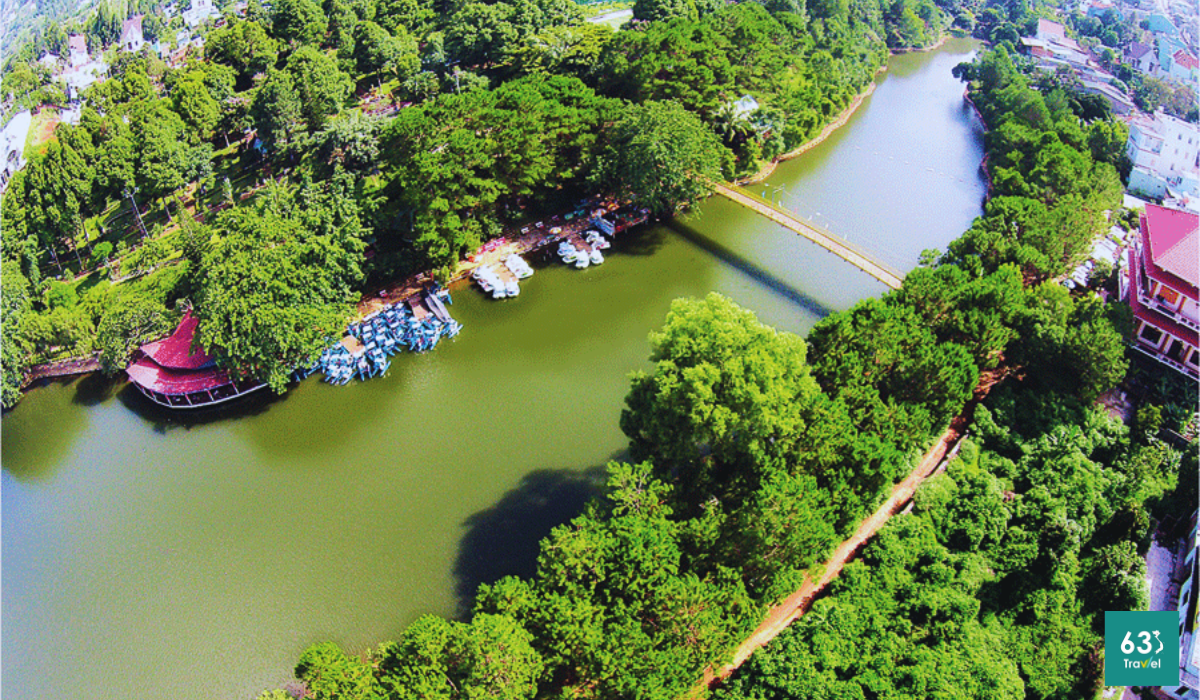
Dreamy Dien Hong Park in the heart of Mountain City
The area around the lake in the park is arranged in a pleasant and comfortable way. Especially in the afternoon, this place attracts a large number of local people to stroll, exercise and admire the beautiful scenery. The dry season from November to April next year is considered the most ideal time for you to visit Dien Hong Park, when the landscape here becomes especially brilliant and attractive.
Duc An Church
Duc An Church, located in Dien Hong ward, Pleiku city, Gia Lai province, is one of the famous missionary destinations of the Central Highlands. Located near the foot of Tay Truong Son mountain, Duc An church carries the unique architectural beauty of Christianity, typical of Pleiku city.
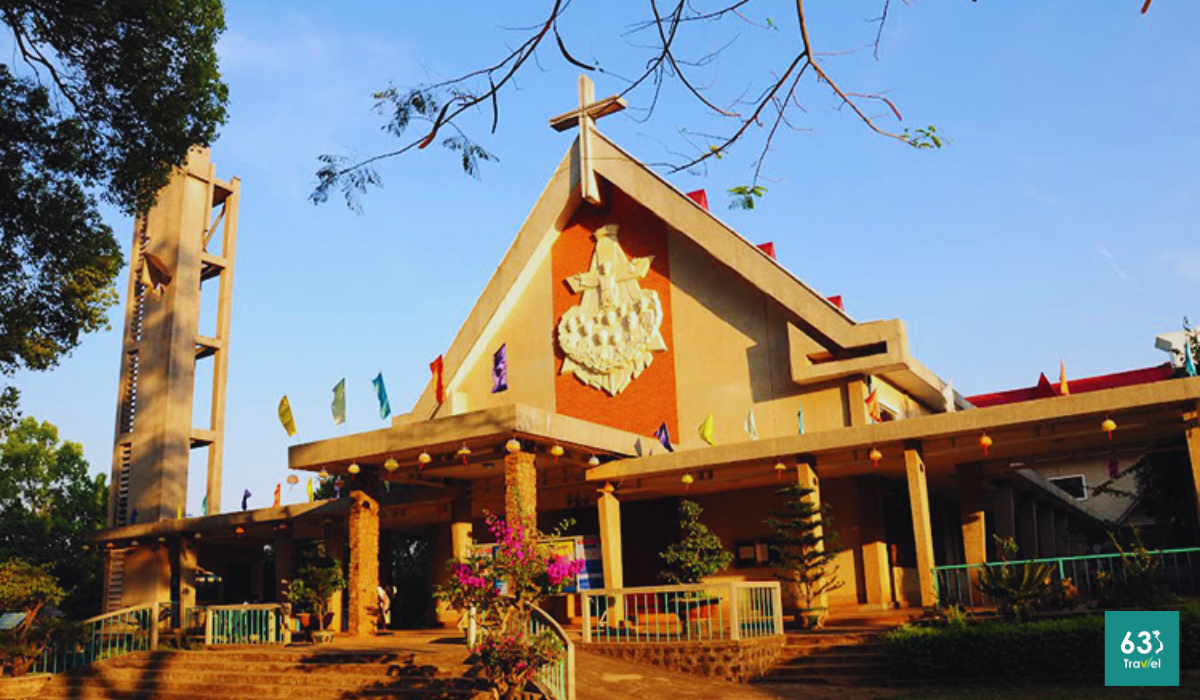
Travel to Duc An Gia Lai Church - a peaceful stop in the mountain town
With its unique and attractive architecture, Duc An church attracts all eyes and makes any tourist passing by unable to stop to explore. This is a destination not to be missed for those who love to explore architectural beauty and learn about the local religious culture.
Hang En Waterfall
Known by both the names K50 Waterfall and Hang En Waterfall, this tourist destination is hidden deep in the primeval forest of Kon Chu Rang conservation area. With a height of more than 50m and a width of up to 100m, the white water of Hang En waterfall stretches like a strip of silver-green silk in the heart of the mountains.
Hang En Waterfall is not only a famous trekking destination of Gia Lai but also a symbol of majesty and wilderness. The scenery of the waterfall with white water pouring down in front of En cave creates a poetic and impressive picture. The sound of birds singing in the fresh air of the jungle adds to the appeal and peace of this place.
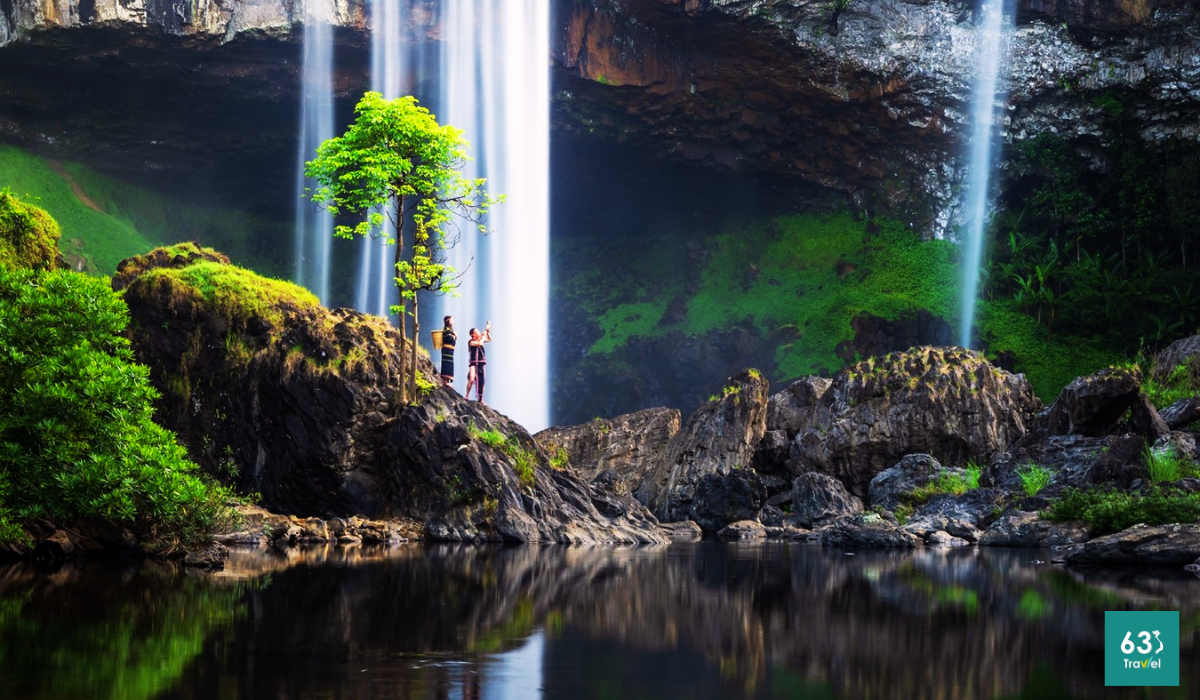
Conquer Hang En waterfall - the muse of Gia Lai mountains and forests
However, getting to Hang En Waterfall is not easy. The road to get here is quite arduous and requires patience and a willingness to overcome the challenges of the terrain. With a long distance through the forest, no homestays or hotels, camping is the only option for tourists who want to experience spending the night here.
Although quite difficult and requires careful preparation, nothing can compare to the feeling of being immersed in the majestic beauty of Hang En Waterfall. The ideal time to conquer the waterfall is from January to June, when the weather is dry and warm, creating the most favorable conditions for this journey of discovery.
So, you have in turn learned the list of 20+ attractive tourist attractions in Gia Lai that fascinate many tourists. Not only has vast mountains and forests, Gia Lai also has many interesting things for travelers to explore. Visit 63Stravel now to learn about tourist attractions and book tickets to Gia Lai to explore this interesting place!
Gia Lai 1686 view
Update day : 18/05/2024
Bien Ho Pleiku (Bien Ho T'nung) in Ede language means sea on the mountain. This tourist destination is located in the northwest of Gia Lai province, about 7km from Pleiku city center if following Highway 14. According to local people, this area was once inhabited by a rich and prosperous tribe. Suddenly one day there was a drought, people performed a sacred Giang worshiping ceremony, the sky and earth began to shake, the land around the village collapsed deeply, the water rose to form Pleiku Lake (T'nung Lake). The weather in Pleiku is divided into two distinct seasons: dry season and rainy season. The dry season lasts from November to April of the following year and is also the most ideal time for you to travel to Pleiku Lake (T'nung Lake). March is the coffee flower season, November and December is the season when wild sunflowers begin to bloom. If you travel in the dry season, you can comfortably move and experience the beautiful flower seasons of the Central Highlands' nature. If you want to travel to Pleiku Lake (T'nung Lake) from April to May, you will have the opportunity to participate in special festivals such as the New Rice Celebration. According to the experience of many people, you should limit travel from May to October because this season often has erratic rain and storms, easily making your journey difficult. To visit the dreamy Pleiku Lake (T'nung Lake), you need to start from the city center and run along Highway 14. Then, you turn onto Le Van Sy street and continue going straight to see Signs show the way to Tonle Sap Lake. When you arrive, you can park your car outside the gate and then walk or rent an electric car to go sightseeing. On the way, if you don't know the way or have difficulty, just look up Google Map or ask local people. In addition, you can also get to Pleiku Lake (T'nung Lake) by Pho Duc Chinh street or Le Dai Hanh street. Although this route is longer and has more traffic, it is much easier to travel. Pleiku Lake (T'nung Lake) is famous for its poetic and charming natural scenery. If you are passionate about the blue lake and vast mountains and forests, you must definitely visit this place in your Travel Guide. Pleiku Lake (T'nung Lake) is surrounded by long, green forests and rolling mountains, contributing to creating a very charming space. The entrance to Pleiku Lake (T'nung Lake) is also through a picturesque road. On both sides of the road are large shadows of ancient trees, spreading coolness throughout the path. In particular, at the end of this street there are stone steps leading to the extremely poetic cage house. At this location, you will be able to admire the beautiful scenery, admire the panoramic view of Pleiku Lake (T'nung Lake) and the majestic mountain and forest space. Traveling to Pleiku Lake (T'nung Lake), you will also participate in many exciting fun activities, associated with wild, dreamy mountains and forests. If you love gentleness, you can take a scenic walk by the lake and enjoy the fresh air. Moreover, you can also rent a bicycle to ride around the lake and admire the vast scenery, visiting ethnic villages nearby. In particular, if you are an adventure lover, you can experience rowing around Pleiku Lake (T'nung Lake). During the journey on the lake, you will watch schools of fish swimming around, fishing, and waiting for the sunset to mark the beautiful lake surface. Pleiku Lake (T'nung Lake) is also an ideal dating spot for "virtual living" believers. This place has a pristine landscape like a painting, so when you visit this place, you will have countless beautiful photos to show off to your friends. Some impressive photography backgrounds that you cannot ignore such as green pine roads, panoramic views of the sea and sky... All of them promise to help you capture many memorable moments.
Gia Lai 1921 view
November to April
Only 30km from Pleiku, the waterfall is surrounded by a pristine, mysterious forest ecosystem. Originating from a river on a high mountain top, with a very strong flow creating a majestic landscape. An additional point is the lush primeval forest with rich and diverse flora and fauna, adding to the wild beauty of the tourist area. The 9-storey waterfall does not fall straight down but curves and weaves along the rugged cliffs, dividing the waterfall into 9 levels, which is the reason for the waterfall's name. Each floor has a height of 5 to 10m, with the last 2 floors being about 15m high. With majestic waterfalls, these are the challenges that visitors want to conquer. The waterfall does not fall straight down massively and majestically, but the sound of the waterfall is not small, it still brings majestic beauty, and the winding water creates a magical and poetic feature. From a distance, the waterfall looks like a dragon bending its body, preparing to fly into the sky. Coming here will definitely give you new experiences and perspectives on wild nature. This famous waterfall is located in La Sao commune, about 15km from the center of Ia Grai district, Gia Lai. If you depart from Pleiku city, it only takes about 40 minutes to travel with a distance of about 28km. Gia Lai has a typical tropical monsoon climate divided into two dry seasons (November to April of the following year) and rainy season (May to October). Visitors can come here at any time, each season the waterfall will have a different beauty. However, to make the trip more complete, you should go to the 9-story waterfall in the dry season, when the weather is dry and sunny, favorable for outdoor picnic activities. Avoid going on rainy days, slippery rocks are dangerous. The summer period from May to the end of August is the time when the 9-storey waterfall welcomes the largest number of tourists. This time is sunny and dry, suitable for picnics, taking photos and cooling off intensely with stream bathing activities. After a long journey, you will arrive at the 9-storey waterfall tourist area, where you will become very small in the midst of vast nature, this is the time for you to enjoy the cool space, with the sound of flowing waterfalls. , the sound of birds singing and an extremely cool green space. Especially on summer days, the 9-story waterfall is considered a "giant air conditioner" that helps dispel the heat, giving you a strange feeling of peace and comfort. Along the waterfall, you will enjoy the cool steam of the waterfall as it refreshes your soul. Explore the high waterfall levels, each level will have a deep blue lake with the bottom visible. The waterfall flows with white foam, where the sunlight shines, creating sparkling, magical rainbows. At Gia Lai 9-storey waterfall, tourism has not yet been strongly developed, so there are not too many outstanding eateries or restaurants here. During your trip to the cascading waterfall, prepare food and light drinks to organize BBQ parties next to the waterfall, it will be great. Before going to this famous waterfall in Gia Lai, you should "pocket" some important travel tips to make your trip more complete, including: If you are a tourist in the North, take advantage of booking air tickets and hotels early to enjoy many incentives, discounts and choose the accommodation you like. As a wild tourist destination, you do not need to spend money on entrance tickets to visit. The road to the waterfall is quite easy, but you should control your speed to ensure traffic safety. Food and water are essential for the trip because there are no restaurants around the tourist area at the waterfall. The terrain here is quite slippery, you should prepare anti-slip shoes to ensure safety while moving around the waterfall area. This is a place deep in the forest, so you should bring insect repellent ointment. During the fun, absolutely do not litter the waterfall, collect clean trash to ensure the beauty of the clean and green tourist area.
Gia Lai 1990 view
From May to the end of August
Possessing a height of about 45m, the waterfall flows on a volcanic lava floor and originates from La Peet stream, pouring down in a rushing, white stream. The peaceful stream flowing into the large Ayun river contributes a small part to the Ayun Ha irrigation system with an area of more than 3,700 hectares. Phu Cuong Waterfall is surrounded by vast natural mountains and forests, creating a diverse and impressive ecological system with towering forests, poetic streams and lakes and majestic vertical cliffs. This place promises to bring you exciting experiences when immersing yourself in the mountain and forest space. Phu Cuong Gia Lai waterfall tourist area is open all day, you can freely visit with a ticket price of only 15,000 VND/person. You will have an enjoyable picnic with interesting activities at the resort. Characteristic of the tropical monsoon climate of the Central Highlands, the weather in Gia Lai is divided into two seasons: dry and rainy. Here, we welcome tourists all year round. Each season, the waterfall has a different beauty. majestic, sometimes gentle like a young girl. During the rainy season around May - October, the amount of water flowing down the waterfall is abundant, the waterfall flows strongly with white foam and the water flows fast. Coming here at this time you will see the majestic and magnificent beauty of the waterfall. nature. In the dry season from November to April, the waterfall flows more gently and gently, although not as majestic as the rainy season, instead it will have a more poetic and peaceful beauty. In the sunshine of the red land of the Central Highlands, soaking in the cool water of the waterfall will make travelers from far away feel more soothed and comfortable. According to Phu Cuong waterfall travel experience, you should spend a whole day to explore and conquer this majestic waterfall. Your job is to prepare good health and a comfortable spirit to explore the mountains and forests of the Central Highlands. Because there are not too many outstanding eateries or restaurants near the tourist destination, we advise you when visiting Phu Cuong waterfall to prepare food and drinks for snacks, or organize exciting outdoor parties. guide in the area near the waterfall. It's wonderful to admire the romantic mountain scenery while enjoying delicious food together. Because there are not too many outstanding eateries or restaurants near the tourist destination, we advise you when visiting Phu Cuong waterfall to prepare food and drinks for snacks, or organize exciting outdoor parties. guide in the area near the waterfall. It's wonderful to admire the romantic mountain scenery while enjoying delicious food together. In addition, you need to note that Phu Cuong Waterfall is a strictly managed tourist destination, so if you want to film, take wedding photos or camp overnight, you need to contact in advance for specific and accurate instructions. When playing on the waterfall, absolutely do not litter. You need to maintain general hygiene, be conscious, and travel civilized to preserve the beauty of the tourist area. The waterfall area is quite slippery and dangerous, do not play, run or jump, play safely.
Gia Lai 1904 view
November to April
Thac Ba Lake is located in the heart of Gia Lai, hidden in winding paths. Hidden within the vast green patches of grass and trees is the Thac Ba stream, which is working day and night to bring water to the villagers here. Thac Ba Lake is a gift that the Creator has lovingly bestowed on this land of the Central Highlands. With a water-shaped design, originating from Ia Nueng village (Pleiku City Lake), water flows here to create Thac Ba Lake. Unlike H'Mun Waterfall, which has white water flowing down from above, vertically, like a giant wall, Thac Ba Lake is a crystallization of water streams located on the ground at a height of about 5m. The lake's water flows down to the mouth of a rock cave and the surrounding area. This place was originally a geological fault in ancient times. According to the village elders living here, in the past, in addition to Ba waterfall, there was also Ong waterfall. Both of these waterfalls were strong and majestic at that time. Unfortunately, the erosion of nature over time and human exploitation has left this pair of waterfalls only half as it is today. For some of you who love to explore tourist destinations with wild and rustic beauty, you have only known about Thac Ba Lake in recent years. Because it appeared a long time ago, the scenery here is still preserved, quite complete. Because of that beauty, Thac Ba Lake has been attracting many people to explore, especially young people. Enjoying the fresh air and pristine natural scenery at Thac Ba Lake is one of the interesting experiences you should try once. Referring to Thac Ba Lake, people often evoke a poetic, majestic scene, symbolizing the rustic beauty of the Central Highlands. According to the travel experience of many young people, the most suitable time to move to Gia Lai and explore Thac Ba Lake is in the summer. The dry season in Gia Lai is from March to August. At this time, the water flow is relatively stable. On the contrary, from August to December, Thac Ba Lake often has heavy rain and strong, extremely dangerous water currents. Therefore, you should limit visiting Thac Ba Lake at these times. Thac Ba Lake not only provides a huge water source to help villagers here have a more fulfilling life. Most of the water from the lake will serve irrigation and daily activities for their lives. Not only that, Thac Ba Lake also contributes to improving the air environment, reducing the temperature here by 1 to 2 degrees Celsius compared to normal. The temperature combined with the cool blue water will make the air here always fresh and pleasant. Up to now, Thac Ba Lake is still a famous waterfall in Gia Lai, still retaining the wild features of the Central Highlands. This is a tourist destination that hides interesting things, attracting many young people with passion and desire to explore nature. Therefore, for those who are passionate about learning about the outside world and want to set foot on Thac Ba Lake to discover many interesting things, the road to get here is a small challenge you need to overcome. From the center of Chu Pah district, you move about 8 kilometers along the road to LaLy Hydroelectric Power Plant, then turn left and you will immediately see the waterfall. According to local people, Thac Ba Lake has existed for a long time, but people have only discovered the beauty of the waterfall in recent years. After all that time, Thac Ba Lake is still peaceful hidden behind the endless green forests of this Central Highlands region. Perhaps that is why Thac Ba Lake still retains its somewhat wild, magical and poetic beauty. For those who have visited Thac Ba Lake, this place seems completely different from Princess Waterfall in Gia Lai. Although the nature of Thac Ba Lake is not as aggressive as other waterfalls, somewhere this place still retains a bit of its own aggressiveness. Thac Ba Lake often randomly releases white foam, creating a spreading cool breeze. Stone blocks of all shapes and sizes mark evidence of time. The rays of sunlight shine through, making the waterfall become even more shimmering silver, a thousand times brighter and more sparkling. The trees around the lake are green like an endless carpet of vegetation, small birds are flying in the clear blue sky, singing soft and peaceful melodies. All the sounds and sights here create a wonderful natural picture that holds everyone's footsteps.
Gia Lai 1885 view
From January to December
About 2km from the center of Pleiku city, located on a gentle hill in the heart of a foggy mountain town, Minh Thanh Pagoda appears as a unique architectural complex with magical and ancient beauty that attracts countless tourists. guest. Built in 1964, through many ups and downs of history causing many parts to be damaged, in 1997 the pagoda was restored and built a new one. After a restoration and embellishment process lasting more than 10 years, Minh Thanh Pagoda seems to be wearing a completely new outfit with a unique oriental beauty influenced by Japanese, Chinese, and Taiwanese architecture. . Up to now, the pagoda is not only a place where Buddhists come to worship and worship Buddha, but also attracts many tourists to visit and sightsee. You will be amazed when admiring the majestic and magnificent beauty of the 16m high, 2-storey main hall with a ceiling made of po mu wood, a famous type of wood in the vast forests of the Central Highlands. . Most special is the large pagoda door made of delicately carved wood. Located on both sides of the main hall is the bell tower and Tu An Tower with 3-storey roofs covered with dragon scale tiles and decorated with stylized dragon and lotus motifs. All create a splendid, majestic and elegant scene in the middle of the fanciful smog-covered Pleiku city. Going inside, the main hall space is harmoniously decorated with four thousand-armed, thousand-eyed Lady Buddha statues placed in the four corners, in the middle is the Buddha altar and thousands of statues carved in extremely elaborate relief against the walls. Outstanding among them are 18 Arhat statues made from jackfruit wood and painted with extremely beautiful gilded vermilion. Outside the temple grounds, many miniature landscapes such as lakes and trees are arranged, creating a clear, fresh and harmonious natural landscape amidst the majestic atmosphere of the temple. Not far away is the 9-storey high Xa Loi stupa, meticulously and delicately carved, adorning the beautiful temple space. With majestic beauty in a unique architectural space, Minh Thanh Gia Lai Pagoda is not only a spiritual temple but also a "captivating" beautiful landscape, attracting many tourists to visit. In the majestic space echoing the sound of distant bells, you seem to find peace in your soul at the peaceful Buddha's door.
Gia Lai 1864 view
From January to December
Kon Chu Rang Nature Reserve is a tourist destination located in Son Lang commune, K'Bang district, Gia Lai province. If you look on the map, this area is located between the East and West of the Truong Son range. Along with that, this place has quite rich vegetation and an extremely magnificent and lively natural network. Especially the mountains and the alternating river and stream system help attract tourists to come here for an unforgettable experience. Kon Chu Rang Nature Reserve has a total area of 719 km², of which the area of the reserve is 159,000 hectares. This place has a system of rapids, rivers, streams, and mountains in the tropical forest that blend together to create a picture of majestic nature. This is even more helpful for tourists who love nature and want to experience the forest. Kon Chu Rang Nature Reserve has a diverse and rich flora and fauna system with many rare species included in the Red Book of Vietnam and the world. The forests here are mainly old forests and primeval forests along with mountains, hills, rivers, streams, and rapids creating a vivid natural picture. In 1986, Kon Chu Rang was included in the list of forbidden forests to be strictly protected. From January to June will be extremely suitable for visiting and experiencing Kon Chu Rang. At this time, the weather as well as the sky and earth begin to change as sunlight intersperses the leaves of the trees in the forest. In addition, the dry climate is also a time when plants and animals can easily grow so the seasons can change, so it will look very poetic. So if you want to explore and take souvenir photos, choose this time to travel! Located in the beautiful Central Highlands mountains, Kon Chu Rang nature reserve is fortunate to inherit in The beauty comes from nature with 1.6 million hectares of primeval forest surrounding it. This place possesses special rare woods that are still intact because they are not affected by human impact. In addition to ecological diversity, Kon Chu Rang nature reserve is also a place where you can admire the magical and majestic beauty of countless different waterfall systems with different natural colors. Together they create vitality here. This Hang En Waterfall area is about 50 meters high, with a width ranging from 20 to 100 meters depending on the season. In particular, this waterfall has an extremely fast vertical flow of water, creating a bright picture of nature. It can be said that the waterfall system created by nature is so beautiful that it touches people's hearts. This waterfall will flow through 3 waterfalls with each waterfall up to 40m long. Meanwhile, the height of the first floor is about 1.5 meters, the second floor is 2 meters and the last floor is up to 20m. The streams at these two waterfalls churn out white foam amidst the peaceful scenery of the mountains and forests, creating a poetic and majestic natural masterpiece. The streams at the foot of the waterfall are also quite wide with large trees on both sides, suitable for you to rest and admire this wonderful natural scenery. Besides the beautiful and attractive waterfalls, you can also visit the villages and houses imbued with the identity of the Ba Na ethnic group living in this reserve. This is also one of the extremely interesting experiences for visitors. In this village, there are up to 60 households living here and doing forestry and agricultural management work to earn extra money. Kon Von village contains many distinct cultural colors. Visitors can experience the authentic life of the Central Highlands and special customs and activities of the Ba Na people. In particular, if you visit Kon Von village during the festival seasons, you will experience buffalo stabbing activities, dancing and unique local dishes.
Gia Lai 1301 view
From January to June
"Jackfruit Garden, Co Hau Field" belongs to the Tay Son Thuong Dao complex, the early base of the Tay Son movement, now in Nghia An commune, Kbang district, Gia Lai province. "Jackfruit Garden, Co Hau Field" is where Ya Do, also known as Co Hau - daughter of a Bahnar chief, wife of Nguyen Nhac, who had the merit of building the logistics force for the Tay Son army in the years beginning of the uprising. She and her compatriots in the area and the insurgents explored a 20-hectare area of land at the foot of Ca Nong mountain (now in Nghia An commune) to grow rice and food crops. In addition, she also planted a jackfruit garden to create more food sources for the insurgents. The fruits of "Jackfruit Garden, Co Hau Field" are a great contribution of Ya Do and the Bahnar people to the Tay Son movement. The memorial stele memorializing Ya Do's gratitude is located on an open plot of land. The stele engraves the merits of Ya Do and the people of Bahnar. The relic was recognized as a national historical relic by the Ministry of Culture, Information, Sports and Tourism in 1991. Right next to the memorial stele house is the green rice field where she and her compatriots reclaimed land in the past. growing food crops, lovingly called "Co Hau's Field" by later generations. Today, households still receive land to grow rice here, keeping the original appearance of the fields. The ancient jackfruit trees are dozens of meters tall, with lush foliage shading the entire forest. Their trunks are as big as a person's arm and have knobby knobs. These jackfruit trees are labeled with names to help people be aware of protecting the monument. The jackfruits are only as big as a kettle and have a crooked waist. Jackfruit is ripening on a tree trunk that has turned brown. In the past, these jackfruit trees were a source of food to provide additional nutrition for the Tay Son insurgents. When Ya Do passed away, her remains were buried at Dat Mountain (Cuu An, An Khe), now in An Dien Bac village right next to her house. After that, An Dien people built a palace to worship her made of wood and thatched. In the 19th century, people rebuilt the palace with bricks, lime, and mortar to worship her. Source: Gia Lai Museum
Gia Lai 2219 view
Tay Son Thuong Dao is the common name of the land located above the An Khe pass area, now belonging to An Khe town, Kong Chro district, Dak Po district and K'Bang district, called Tay Son Thuong Dao. to distinguish it from the lower Tay Son district, Tay Son district of Binh Dinh province. The Tay Son Thuong Dao relic complex currently includes 17 relics divided into 6 clusters distributed mainly in An Khe, and partly in Dak Po, Kong Chro, and Kbang. This complex was officially ranked as a national historical relic by the Ministry of Culture, Sports and Tourism in 1991 and will continue to be ranked as a special national historical relic in 2021. An Khe town is the main area of the Tay Son Thuong Dao relic complex where Tam Kiet (the three Nguyen brothers) chose to be the base to launch the legendary Tay Son movement. This is a place where, thanks to the rugged terrain, the vast mountainous forests and protected Ba River, this place also has very rich sources of forest products and land, suitable for raising soldiers and expanding the force. Food and grain storage during the early period of the uprising was also the starting point for the glorious historical journey of the Tay Son Dynasty. The entrance area is a large gate with two rows of monolithic stones and Bahnar gongs bearing the breath of Central Highlands culture. The gate area is also decorated with embossed reliefs of the Tay Son uprising such as people riding elephants, scenes of communal houses, scenes of carrying goods to battle, rivers, streams, and hills. The delicately crafted images express joy, steadfastness and confidence in the cloth-clad heroic leader, and belief in victory. Passing through the gate, visitors will see two rows of stone horses sculpted full of courage and pride with extremely prominent white color. The horses are sculpted in a galloping position towards the gate, with elegant and heroic lines. Entering the center of the Tay Son Thuong Dao relic area, visitors will see the Tay Son Tam Kiet communal house, the Tay Son Thuong Dao museum and An Khe Truong. Tay Son Tam Kiet Temple has ancient architecture with traditional tiled roofs, columns carved with ancient embossed motifs, in front of the temple is a very large painted pond surrounded by gray stone pillars creating a unique landscape. harmonious accent. Meanwhile, Tay Son Thuong Dao Museum is a place to store and display artifacts and pictures about the uprising. Coming to the Tay Son Thuong Dao historical relic site on the 4th and 5th days of the Lunar New Year every year, visitors will participate in the Hue Bridge Festival to commemorate the Tay Son uprising. The festival consists of two main parts: the ceremony with solemn rituals according to ancient customs to pray for good weather and peace, the country and people are safe, and the festival part is traditional cultural activities such as performing Tay Son traditional martial arts, performing arts. gongs, ring fighting, playing folk games... The scale of the Hue Bridge festival is very large, demonstrating unique culture and preserving traditional cultural beauty, contributing to promoting the historical value as well as promoting tourism of the Tay Son Thuong Dao relic area. Over hundreds of years, the relic still stands the test of time as a reminder of the roots and heroic past of our ancestors so that the next generations can build a more prosperous and beautiful homeland. Source: Gia Lai Tourism
Gia Lai 2175 view
Plei Oi Historical-Cultural Relic Area is located in Plei Oi village - Ayun Ha commune, recognized as a National Historical-Cultural Relic in 1993. The place preserves many cultural values, including "Ceremony". Yang Potao Apui's rain prayer" was recognized by the Ministry of Culture, Sports and Tourism as a national intangible cultural heritage on June 8, 2015. This place also preserves almost intact artifacts such as: Magic sword, Oi Tu gong set, Chu Tao Yang mountain; Potao APuih tomb area, ancient Jrai people's house area, water wharf area... According to the Jrai people's concept, when humans are born, all things appear, at this time there is a god who gives water particles to bring life. for all things it is the God of rain. The god brings luck and happiness to people. In Jrai legend, there are 14 generations; The fire king "Potao Apui" used his magic sword to pray for rain when he was in the planting season or in the middle of the farming cycle and encountered drought or crop failure. Therefore, every year, Jrai people conduct a rain-praying ceremony to pray for heaven and earth to grant good rain and wind, good crops, a prosperous life for the people, and everyone to be safe and healthy. Here, visitors will experience the sacred and mysterious festival space; witnessed the Potao Apui (Fire King) using magic swords to pray for rain when the harvest season was about to begin or in the middle of the farming cycle but encountered drought and crop failure; In the minds of the Jrai people, if they displease the gods, they will not be given rainwater, causing illness and constant hunger and cold. In addition, special art programs are being urgently practiced by units and people with the desire to offer visitors elaborate, attractive and interesting performances such as: Gong dancing of local Jarai people; Directly participate in dances to invite wine, dance from the Northwest girls, traditional throwing game of the Tay ethnic group... Coming to Ayun Ha Irrigation Lake Ecotourism Area, visitors will admire the largest irrigation project in the Central Highlands, located in Thanh Thuong A village, Ayun Ha commune, at the foot of Chu Se pass, far from Highway 25. 1 kilometer. With an area of nearly 40 km2, the total irrigation water flow is 253 million cubic meters, providing abundant water resources in Phu Thien district and surrounding areas. There, visitors will enjoy the vast, rich space of hills, mountains, young water, charming and intimate, and visit the Ayun Ha Hydroelectric Plant with its green, peaceful campus. In addition, the lake surface is also a place to organize canoe and boat activities to serve visitors. Besides. Quang Son Pagoda is located in Thanh Thuong A village, Ayun Ha commune, 8 km west of the district administrative center, led by nun Thich Nu Nguyen Nhut, Quang Son pagoda is located at the foot of the mountain surrounded by green forests. Along with the Ayun Ha main canal system, it creates a solid fulcrum for charming mountains and water, meeting the religious needs of people from everywhere. Source: People's Committee of Ayun Ha commune - Phu Thien district - Gia Lai province
Gia Lai 1964 view
Pleiku Lao House is located on a high red soil hill, Thong Nhat Street, Dien Hong Ward, Pleiku City, Gia Lai Province. The prison was built by the French from 1925 to 1941 and was solidly repaired. The total area of the prison area is about 7 hectares, surrounded by solid 3m high walls with layers of barbed wire fencing. In the northwest and southwest corners, there are two guard posts with armed soldiers on duty 24/7. In the east, there is a guard bunker. During the early period from 1925 to 1945, Pleiku prison was the place where France imprisoned patriots and some communist party members active in the Bau Can and Bien Ho Red Relief Associations such as: Phan Luong, Nguyen Ba Hoe, Tran Ren, Lam Thi No. From June 1946 to 1954, France exiled prisoners of war and political prisoners through extreme torture and execution such as comrades Nguyen Dong, Nguyen Nho, Dao Lut, and Le Gioi. In June 1948, the prison cell was established, contacted the outside organization and established a commune cell, Bau Can plantation, and the prison cell formed a joint cell with comrade Ho Hoan as secretary. led the fight against harsh prison regimes, against beatings, limited hard labor, protected the personality of communists and organized prison escapes. In the years 1965-1968, the revolutionary movement developed strongly and widely throughout Gia Lai province and during the 1968 Tet Offensive, political prisoners of Pleiku prison united to attack the enemy by sabotaging the enemy. The prison escaped, but the enemy shot and killed 46 people and injured many others. After the Tet Offensive, at Pleiku prison, the enemy locked up 800 political prisoners, and at this time the harsh regime of prisoners was also strengthened; However, with faith in the victory of the revolution, the revolutionary soldiers imprisoned by the enemy here were not afraid of sacrifice and hardship, remained united, persevered, and did not surrender to the enemy. In July 1968, the prison Party Committee was established with comrade Nguyen Kim Ky as secretary, leading the fight against the enemy right in the prison. The brutal forms of torture, both physical and mental, by the enemy still could not subdue the will and indomitable spirit of the revolutionary soldiers. On the afternoon of March 15, 1975, political prisoners rebelled to liberate the prison, ending 50 years of control by the imperial prison regime. On December 12, 1994, Pleiku Prison was decided by the Ministry of Culture and Information to be recognized as a national historical relic. Pleiku prison is one of the "red addresses" to educate revolutionary traditions for the people, especially pupils and students. Many Party organizations and Youth Unions have chosen this place to organize activities, recruit party members, union members and meet and listen to former prisoners tell stories. This place has become a tourist attraction for domestic and foreign tourists every time they set foot in this land rich in revolutionary tradition. Source: National Museum of History
Gia Lai 1894 view
Hero Nup Memorial House - Stor resistance village is a typical historical and cultural relic of Kbang district, Gia Lai - a land rich in revolutionary tradition. Evidence on this land includes many provincial and national historical relics. One of them and the most typical is Stor resistance village relic - Hidden Heroes Memorial House. Hero Hiding as a leading bird of the revolutionary movement, fighting against the enemy to save the villages and country of ethnic minorities in the Central Highlands. The Hidden Hero Museum, also known as the Hidden Hero Memorial House, was built in 2010 and inaugurated on May 6, 2011, this is also the pride of the people of the Central Highlands. The museum is like a big house located in Stor village, To Tung commune, Kbang district, Gia Lai province. The Stor Resistance Village relic has become a symbol of the Central Highlands peoples, a symbol of courage, resilience and passionate patriotism. This is a place not to be missed when coming to this place, visitors come to commemorate the national hero who devoted himself to the great resistance. This relic was built on an area of 5 hectares, the combination of tradition and modernity creates a unique character for this place. The large gate opens to welcome visitors. When coming to the relic site, visitors will also be warmly welcomed by the people of Stor village with friendly smiles. If possible, they can also enjoy traditional festivals of the Bahnar people and feel the dances. sinuses, Gong sounds of the villagers and rustic dishes but it has become a specialty of the village. Stepping inside, you will see the memorial area and statue of Hero Nup and on both sides display many artifacts, images, precious documents about the life and career of Hero Nup along with many documents. records about the resistance village of Stor. Inside there is a model room simulating the resistance war against the French colonialists of his villagers. His real name is: Dinh Nup was born in 1914 and died in 1999 in Stor village of the Bahnar ethnic group. He was the leader of the people of Stor village to stand up against the enemy. Pictures and memorabilia of his life show the glorious victories and simple life of the national hero. Hero Nup Memorial House is a place to store valuable artifacts, over 400 pictures, documents, memorabilia of Hero Nup and many typical cultural artifacts of the Bahnar people. The simple and simple yet heroic and resilient beauty has created a special attraction for tourists. The environment here is fresh, the people's daily life is still very traditional, the people here are extremely open and friendly to everyone and visitors from other places will leave us with an unforgettable impression. . Source: Gia Lai Museum
Gia Lai 1872 view
The historical relic of Martyr's Tomb Memorial Temple is located on Nguyen Viet Xuan street in residential group 11 (now residential group 3), Hoi Phu ward, Pleiku city, Gia Lai province. The historical relic of the Martyrs' Tomb Memorial Temple in Hoi Phu is the resting place of more than 200 martyrs who heroically fought and died during the 1968 Tet Offensive and Uprising in Pleiku town - Gia Lai. The 1968 Tet Offensive and Uprising took place in Pleiku town, starting from the night of the 30th to the morning of the first day of the 1968 Tet Offensive and lasting until the 3rd day of the Lunar New Year, with nearly a dozen units from the company arriving. The battalion and civil service officers attacked Pleiku town and attacked many enemy headquarters. In particular, the force of Zone 9 (Pleiku town - now Pleiku city) includes special forces company C 90 and special forces company C21; Summary of the 1968 Tet Offensive and Uprising campaign in Pleiku town: The army and people of our province (mainly the Pleiku town front) killed nearly 3,500 enemies, destroyed 500 military vehicles, 35 artillery pieces. and a number of aircraft of all types, burning nearly millions of liters of enemy gasoline. In coordination with the military attack, 11,000 people took to the streets to protest for political struggle. Revolutionary governments in a number of hamlets and communes in districts (Zones) 3, 4, 5, 6 were established. More than 14,000 compatriots destroyed strategic hamlets and returned to their old villages, and 11 villages on the outskirts of town were liberated. After the General Offensive and Massive Uprising of the Mau Than Tet, General - Vo Nguyen Giap, on behalf of the Standing Committee of the Central Military Commission, sent a telegram "warmly praising the recent achievements of the army and people of Buon Ma Thuot town, Kon Tum, Pleiku and Tan Canh town". On February 6, 1968, our State commended and awarded the "Fatherland Merit Medal" to the soldiers and civilians of Pleiku town, and at the same time, the security forces of Pleiku town (Area 9) were also awarded the Meritorious Service Medal, class 1. 3. In 2020, the C90 special forces company was honored to receive the title of Hero of the People's Armed Forces. The 1968 Tet Offensive and Uprising had great significance for Pleiku town: Immediately after liberation, Pleiku town authorities always paid attention and took care of the common graves of martyrs. To commemorate the merits of the martyrs, the Party Committee and Pleiku town government did not move the remains of the martyrs to the cemetery but kept the same position. In 1993, Pleiku town rebuilt the mass grave on the spot with "The Fatherland Recognizes Merit" station and each side has a stele recording the units participating in the campaign and the number of soldiers and officers who died in the 1968 Tet Offensive and Uprising in Pleiku. From 2004 to 2005, the Party Committee and Pleiku city government renovated and rebuilt the common grave with solid reinforced concrete and spacious granite tiles at the old location. Newly built memorial temple, guest house, stele, and ornamental garden. In 2020, the bell tower was built and the guest house was renovated. With the value, meaning and importance of the monument to the historical development of Pleiku - Gia Lai, it is also the wish of the relatives of heroic martyrs from all parts of the country whose children died in the war. 1968 Tet Offensive campaign in Pleiku town. On March 5, 2007, the People's Committee of Gia Lai Province decided to classify the historical site of the Martyrs' Tombs Memorial Temple, group 11, Hoi Phu ward, Pleiku city, Gia Lai province, as a provincial-level historical relic. Every year, the Party Committee and People of Pleiku city organize a visitation ceremony, offering flowers and incense at the relic site, especially on the occasion of Lunar New Year, March 17, April 30, July 27, September 2 and other political events of the city. Source: Gia Lai Provincial Museum
Gia Lai 1817 view